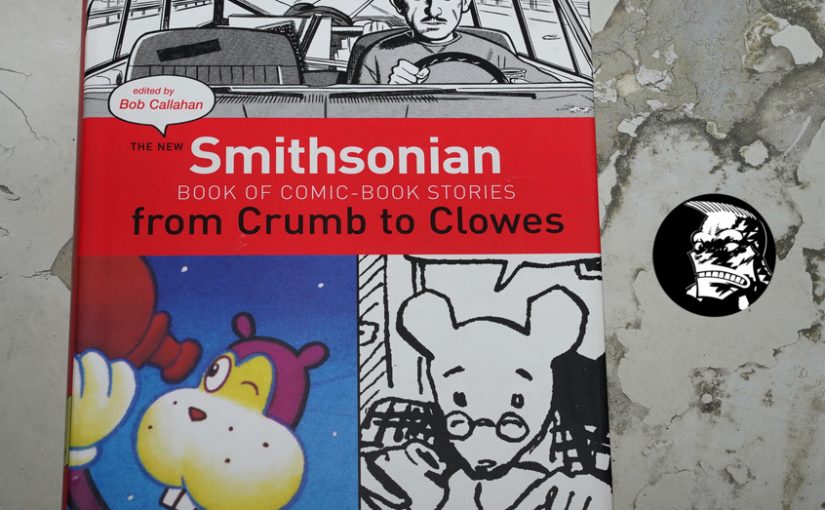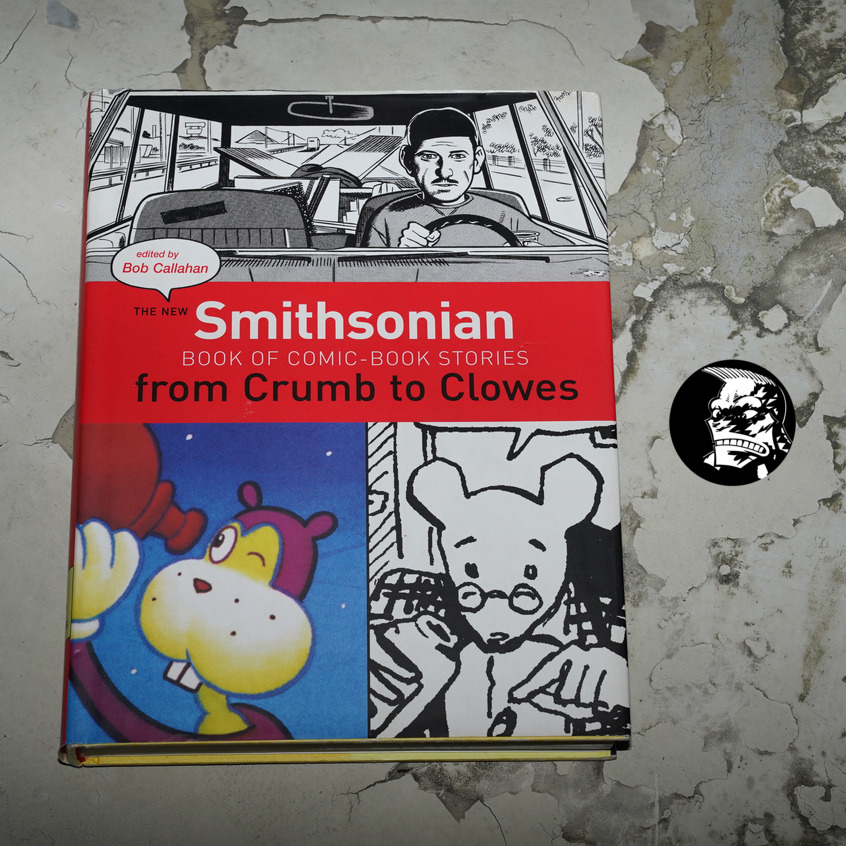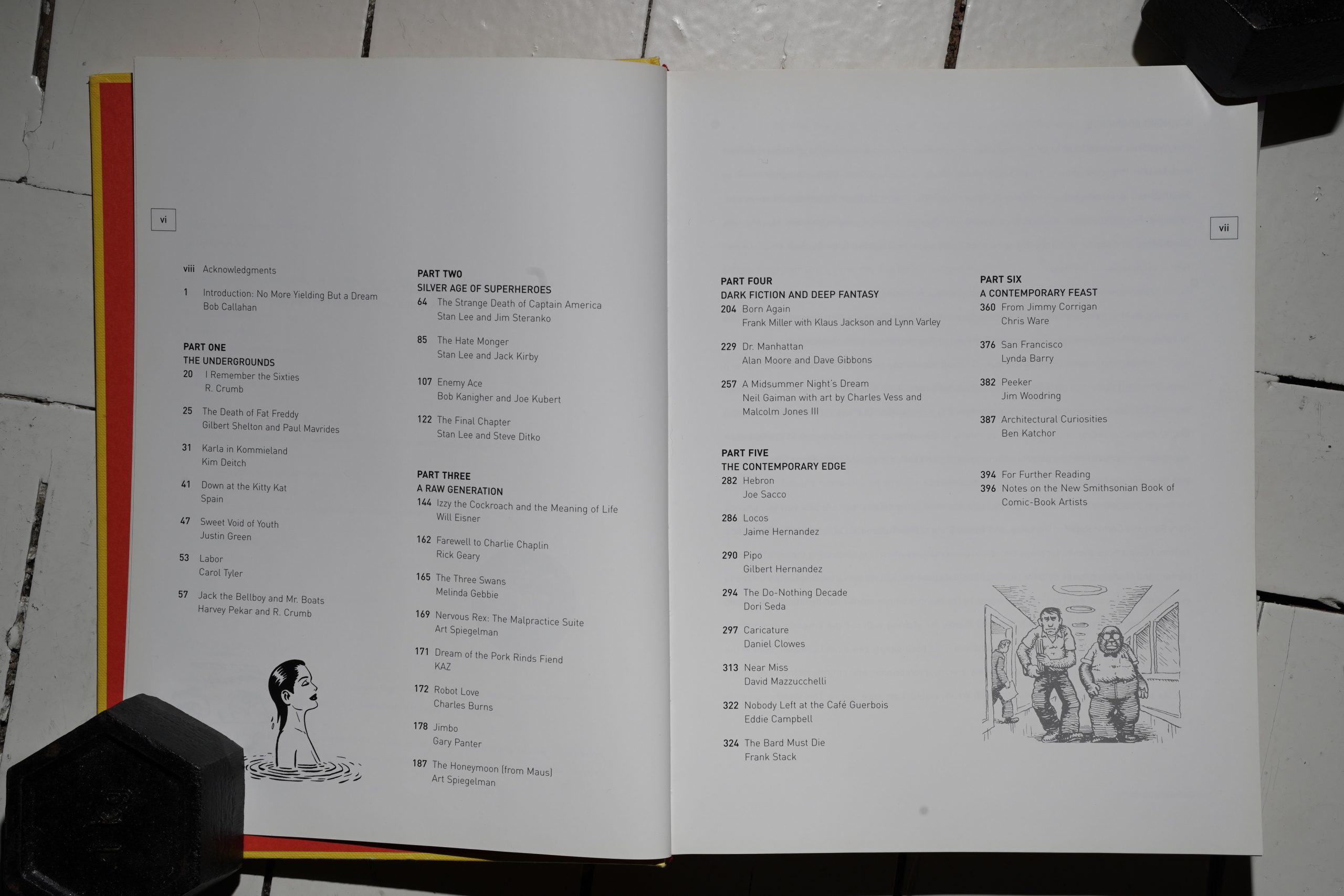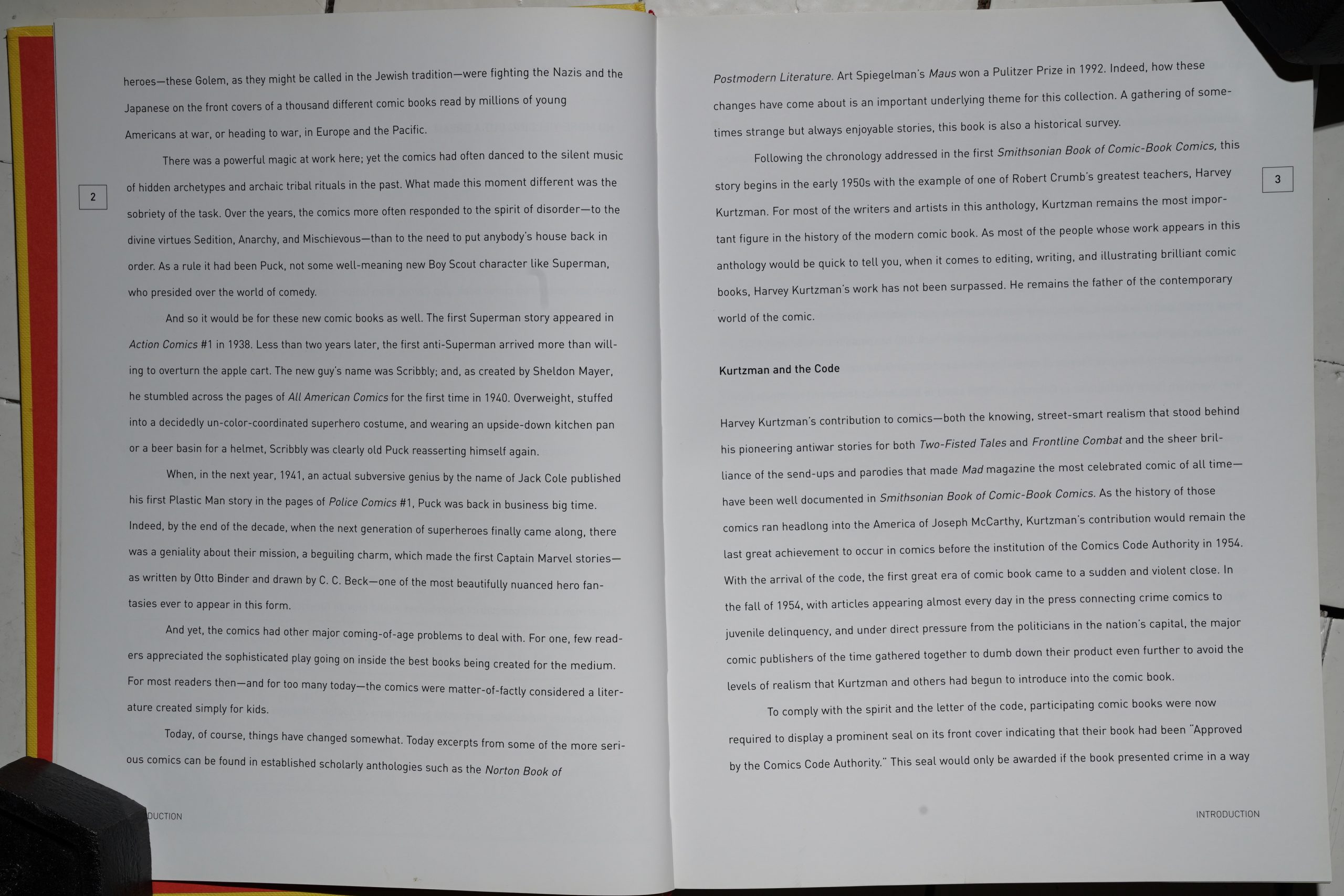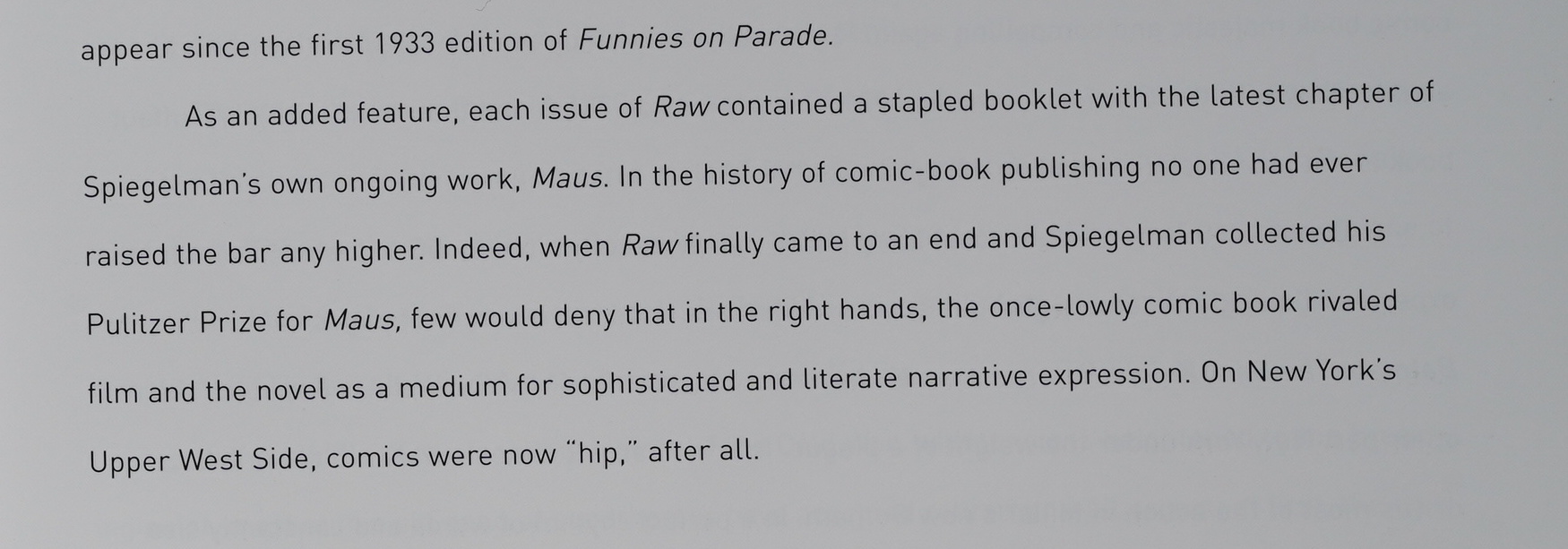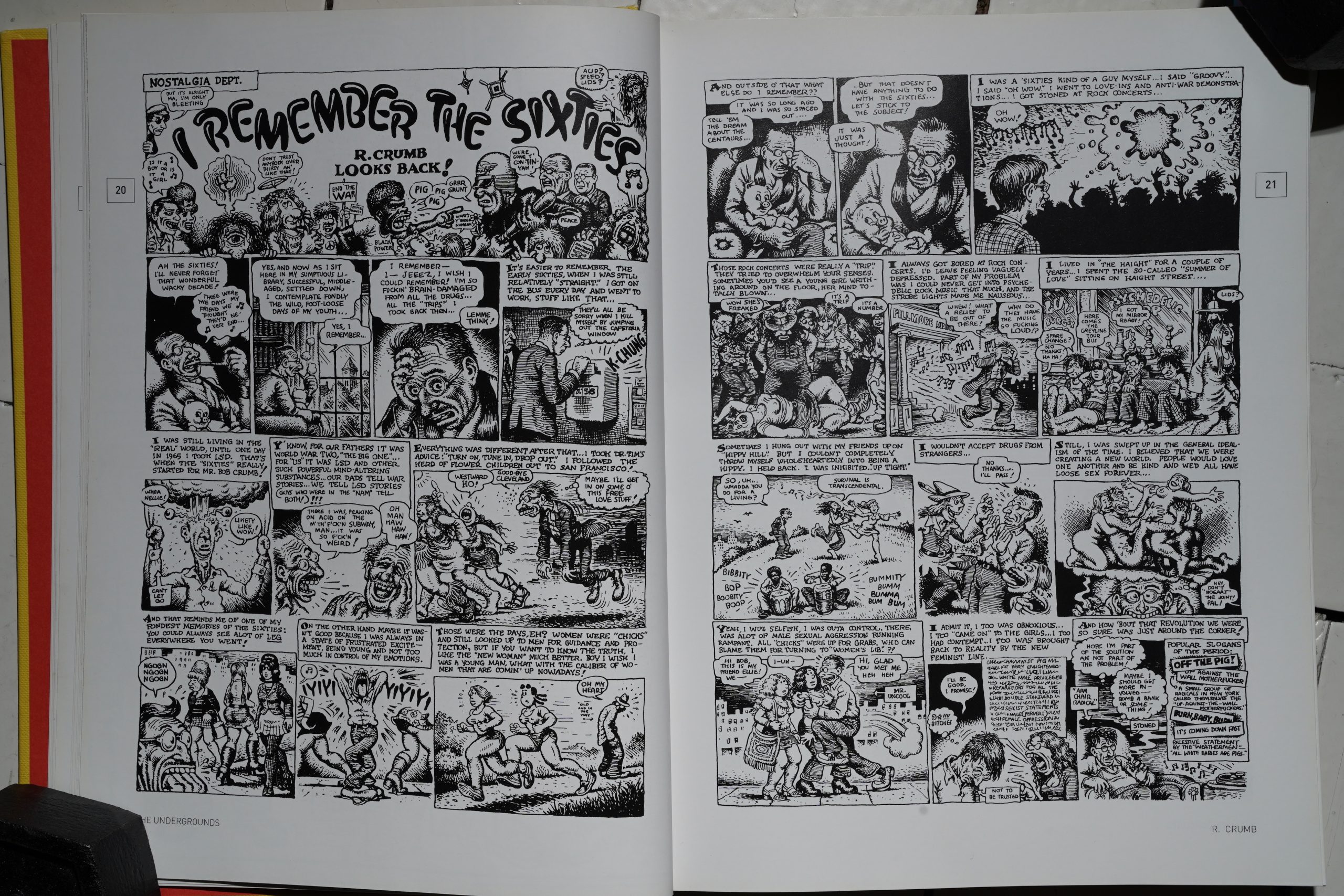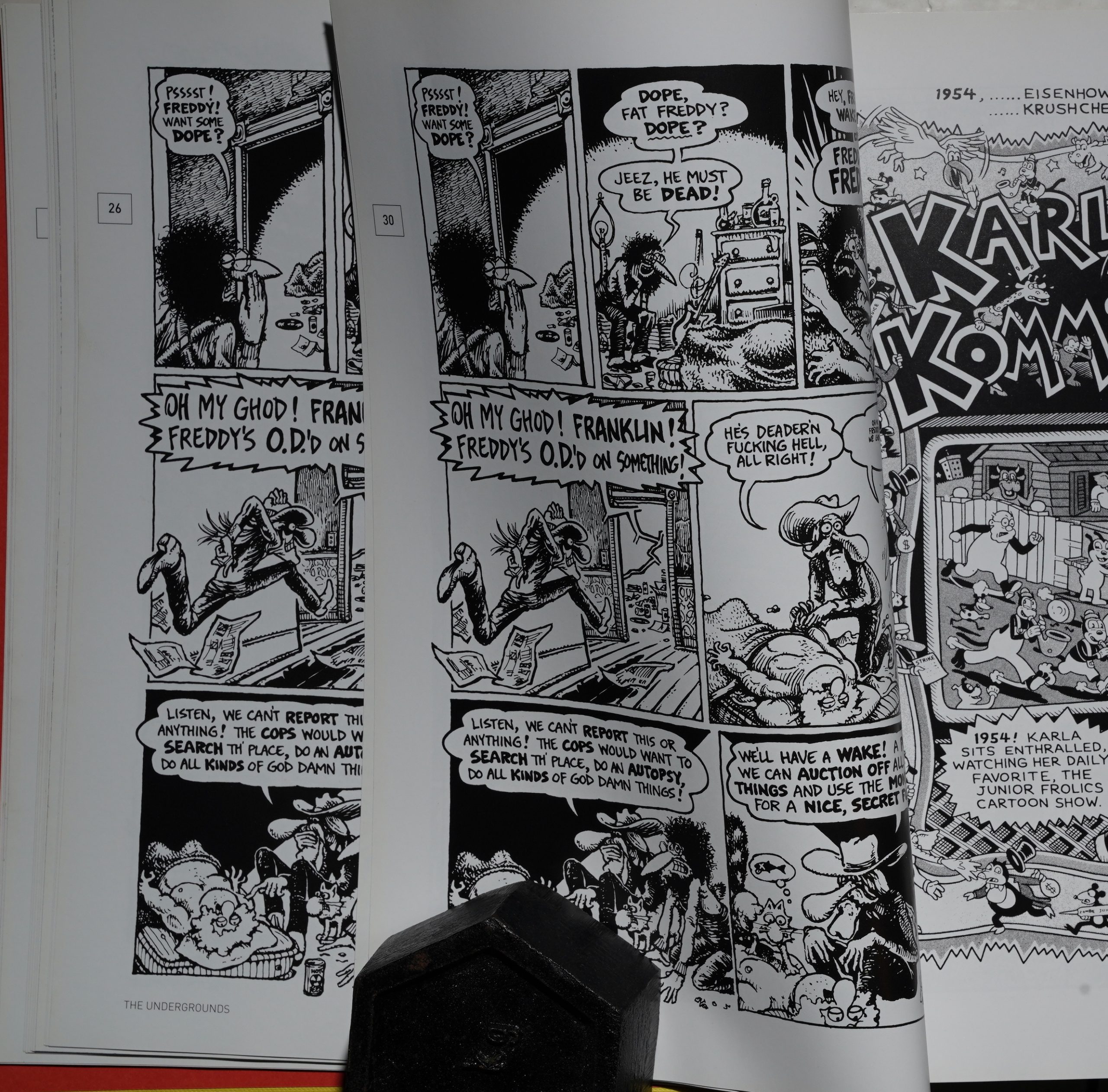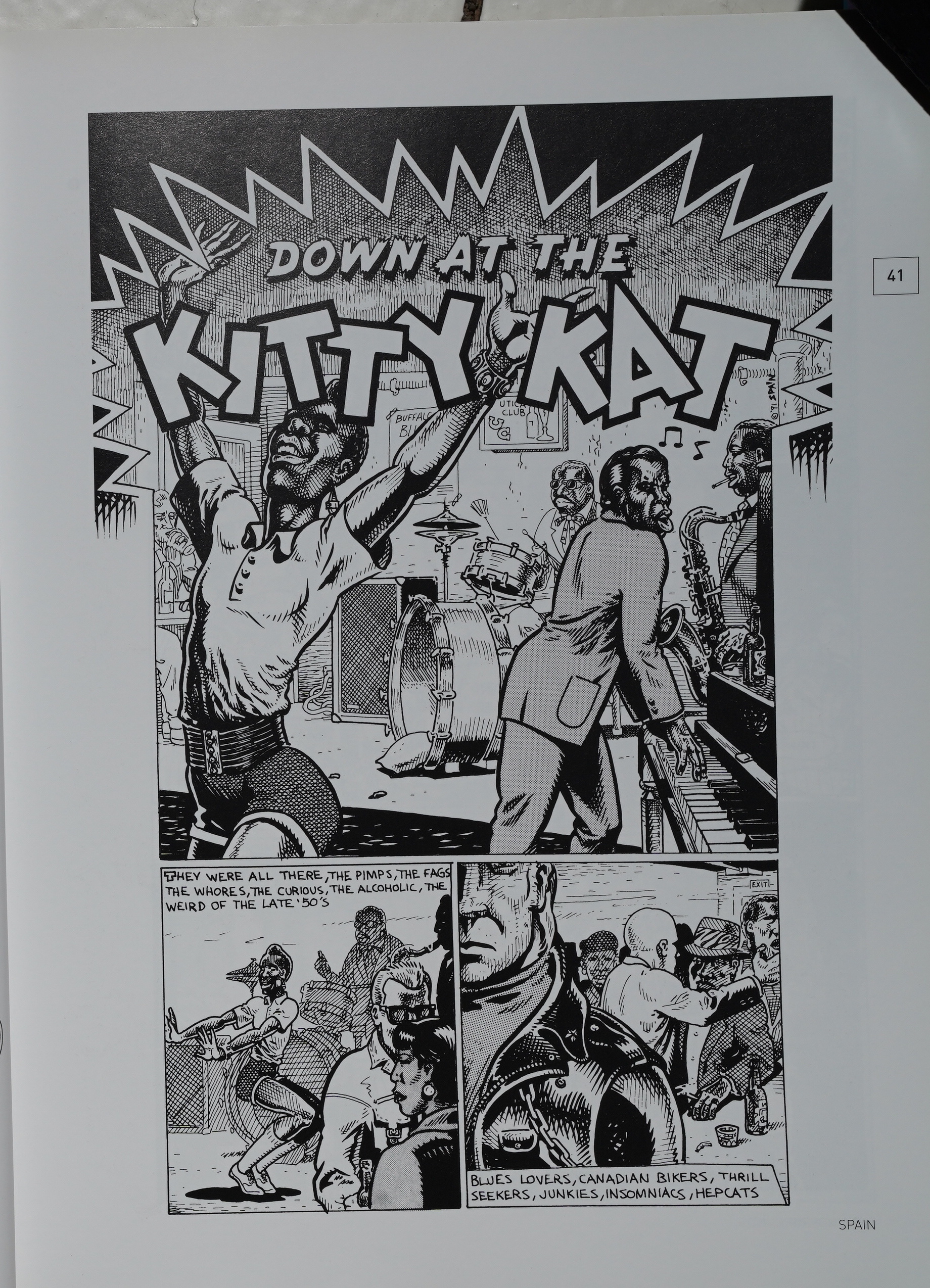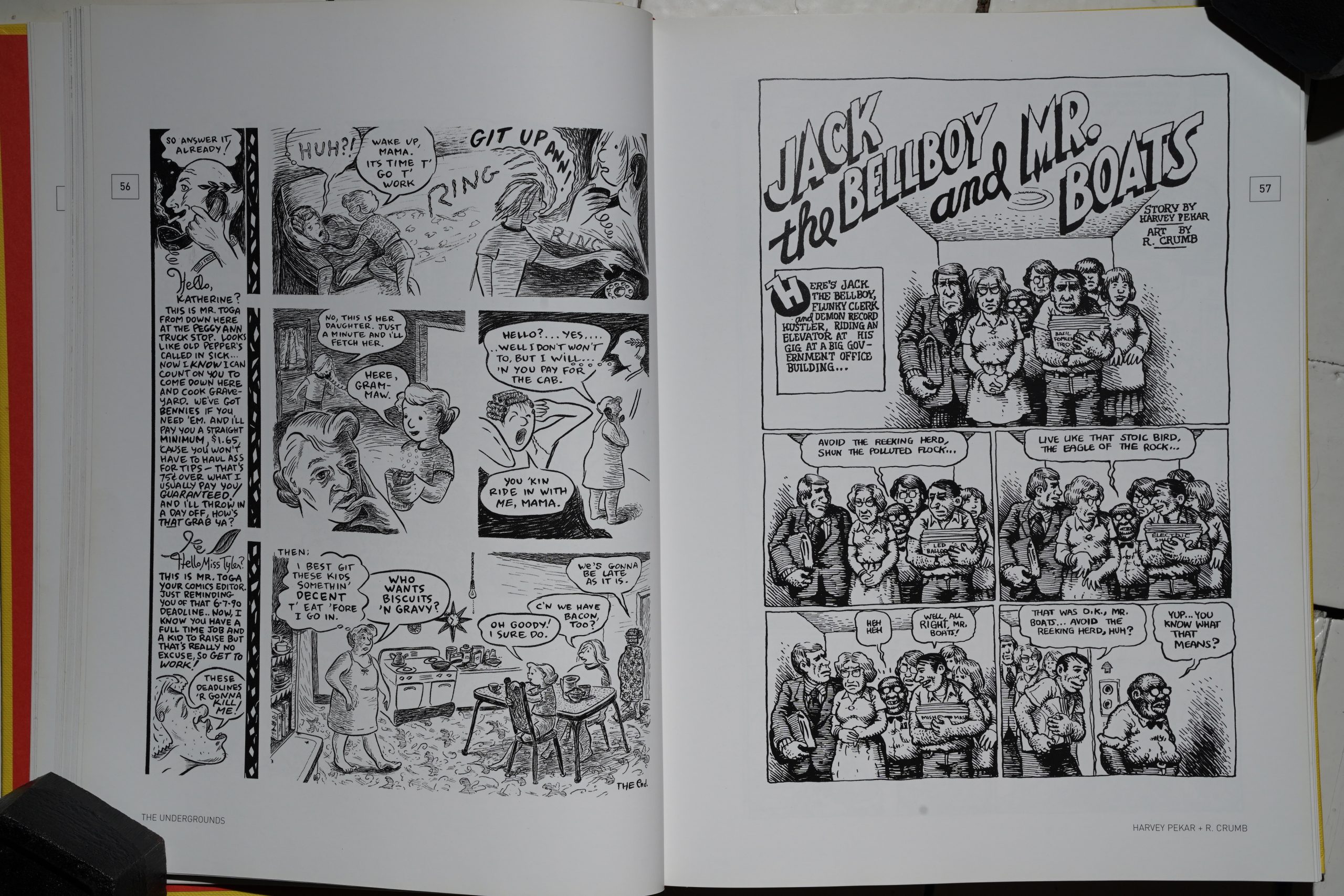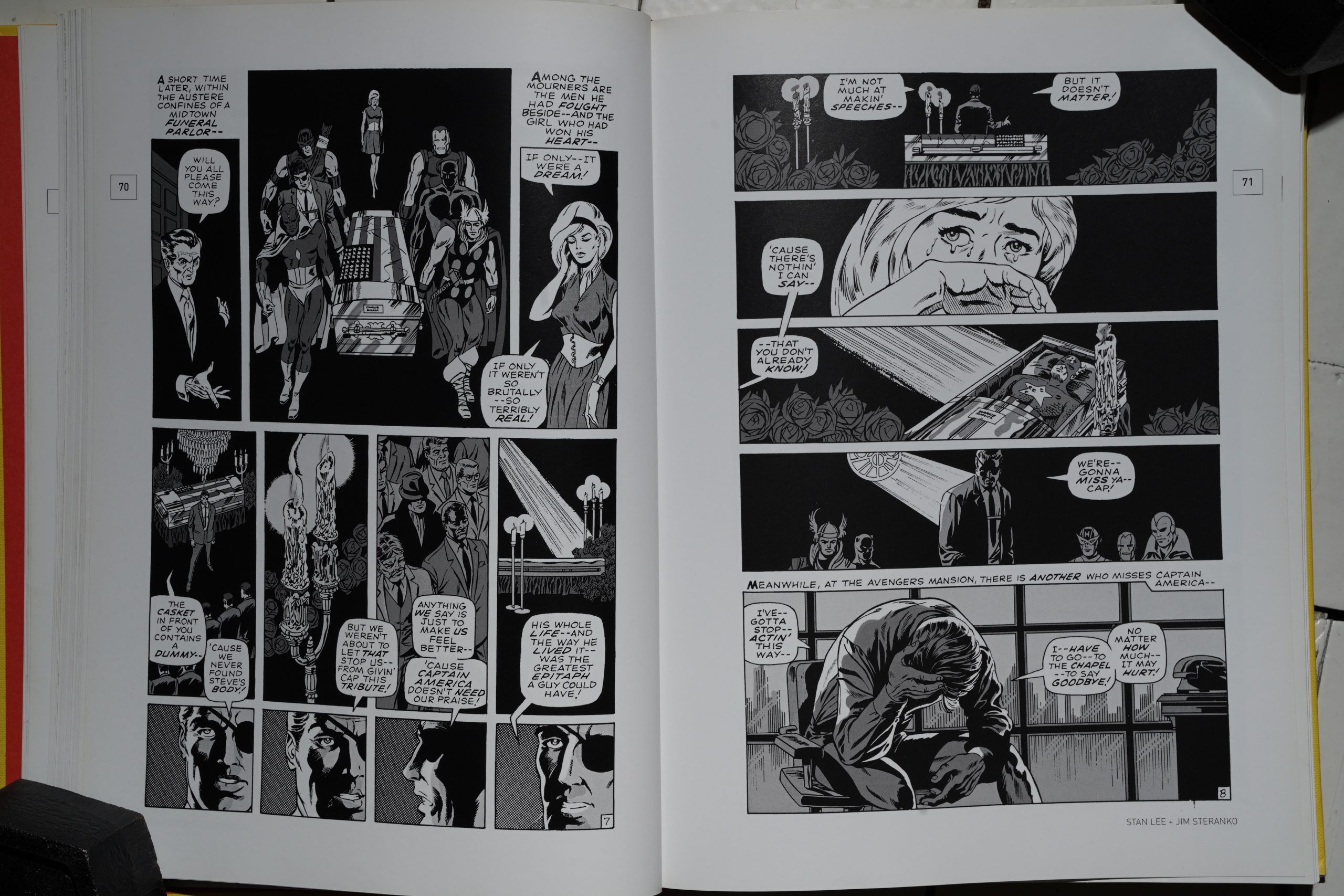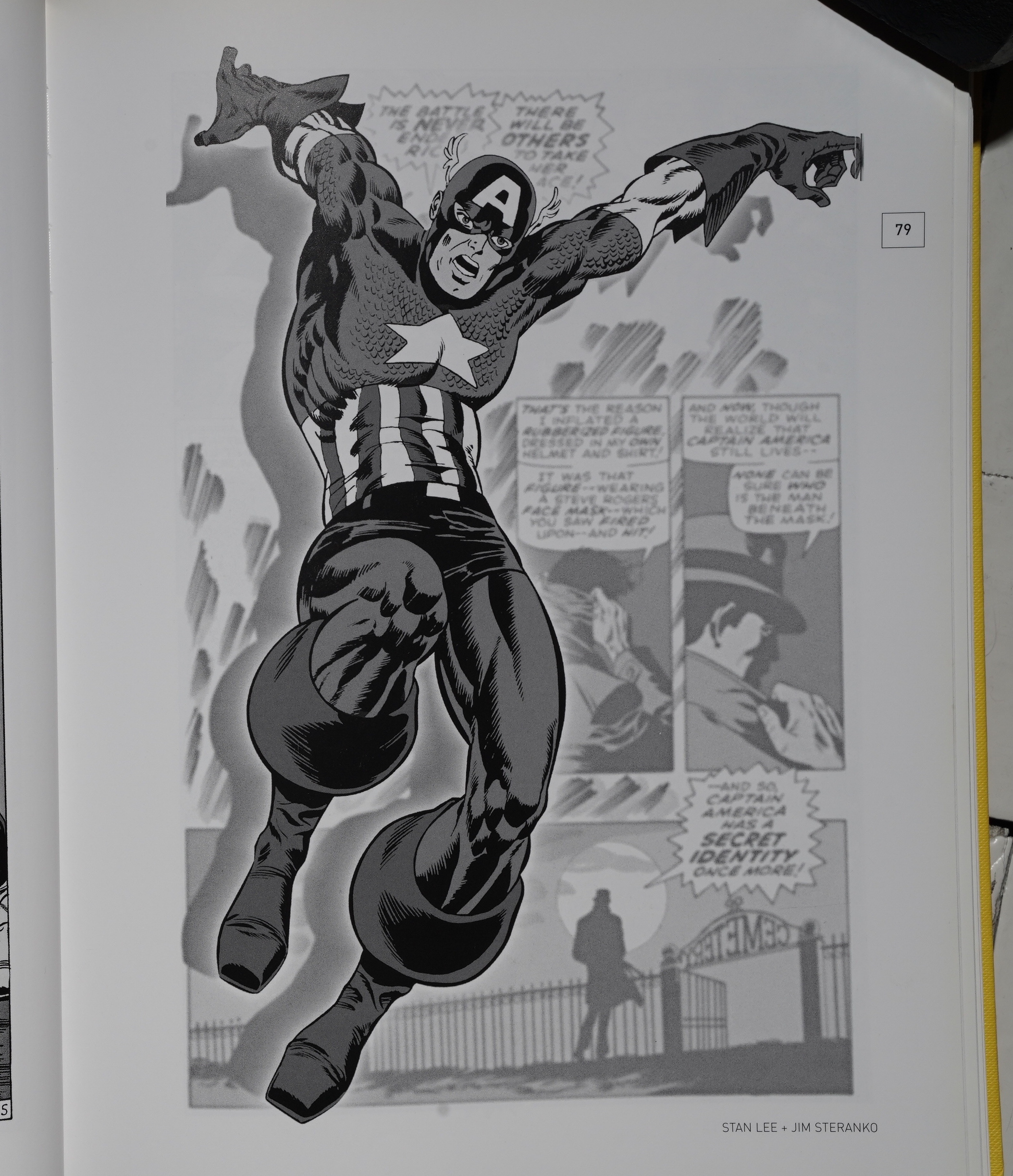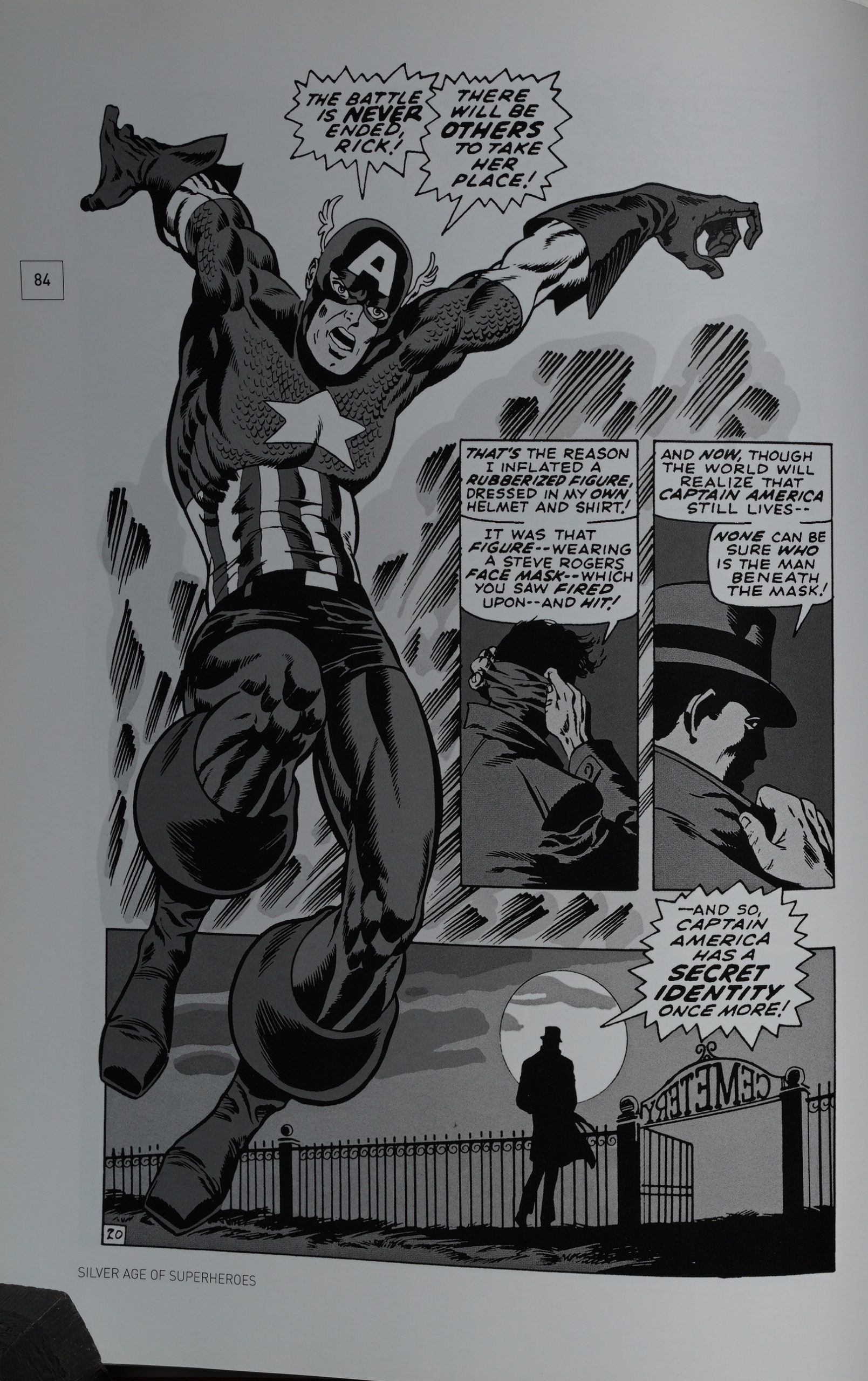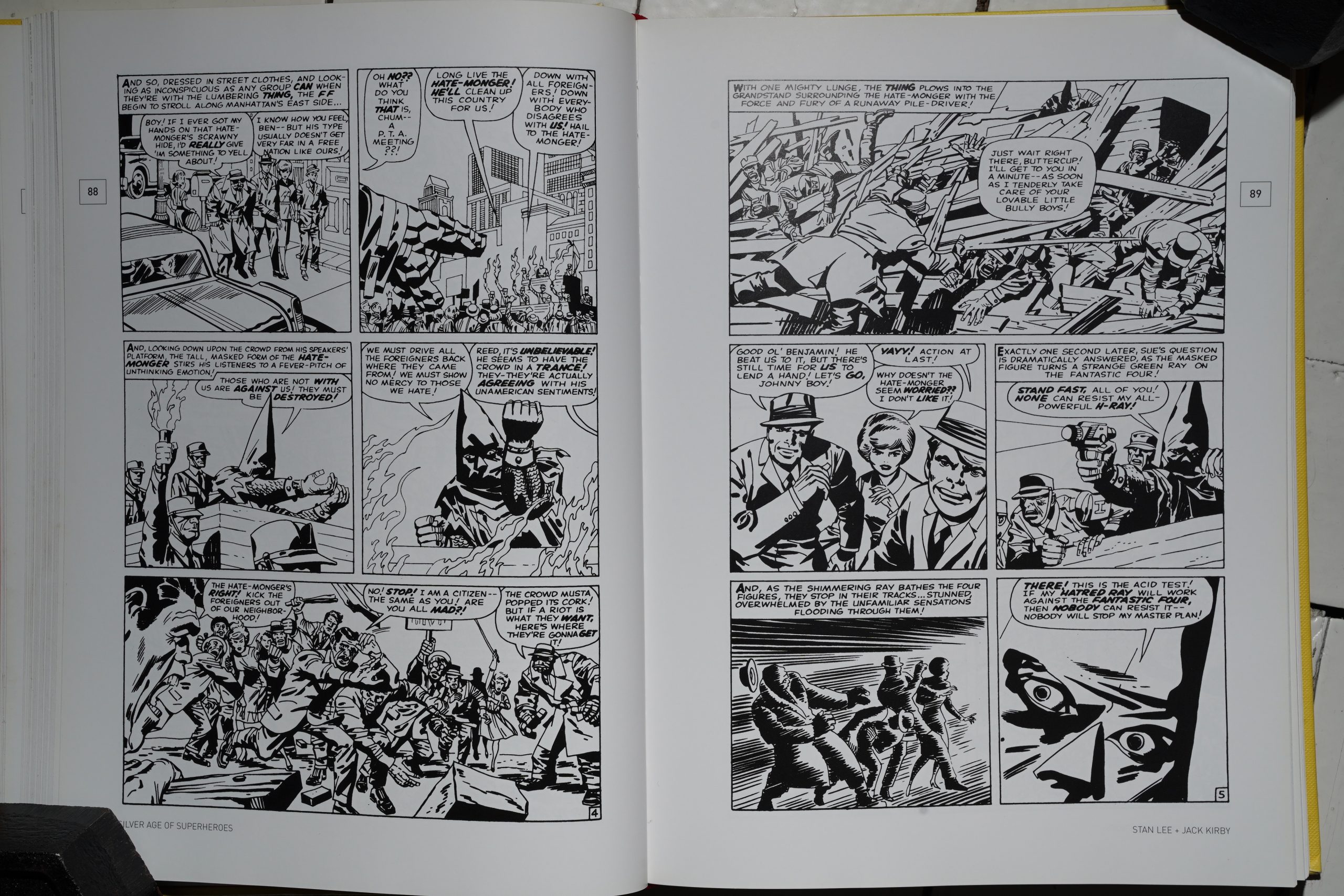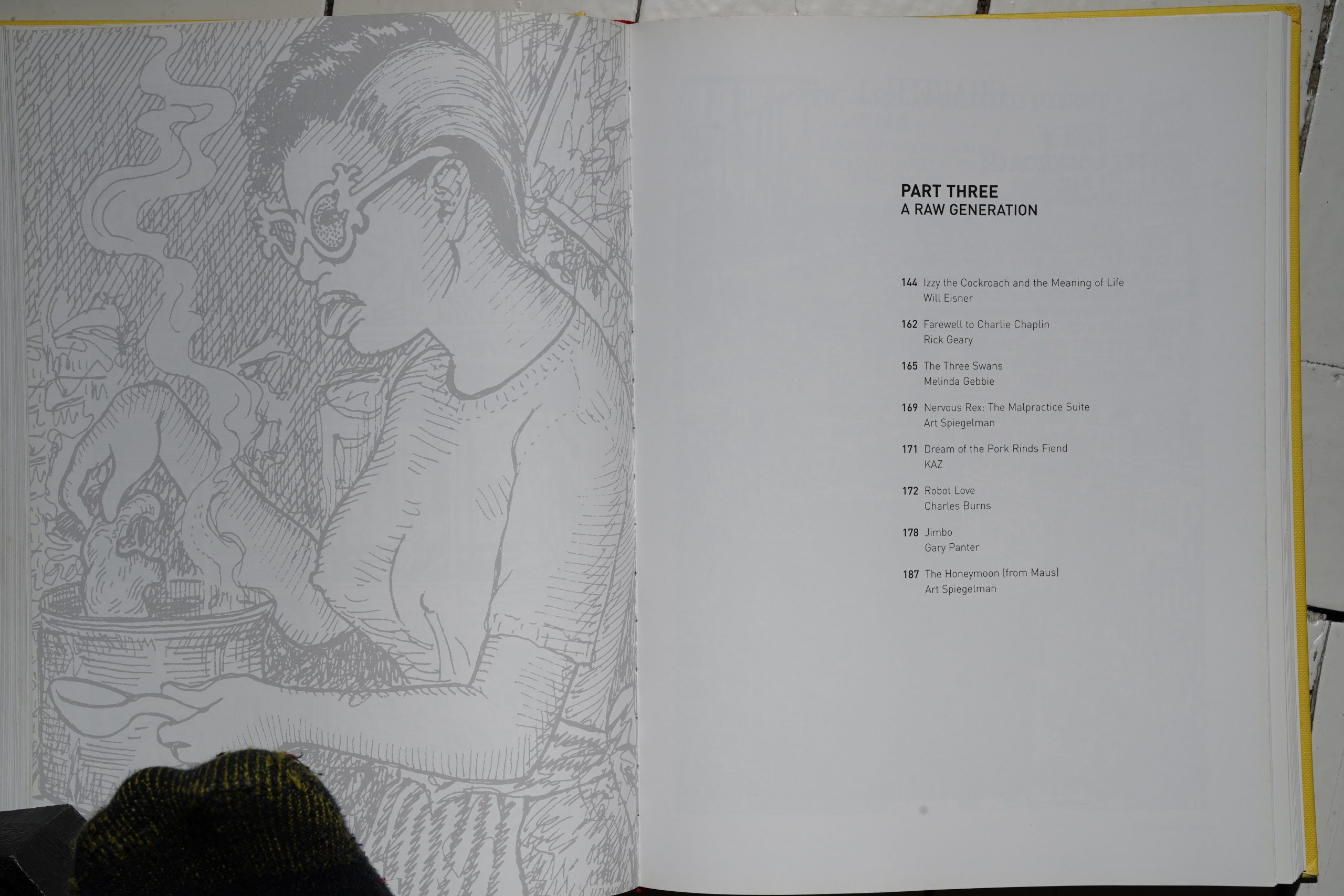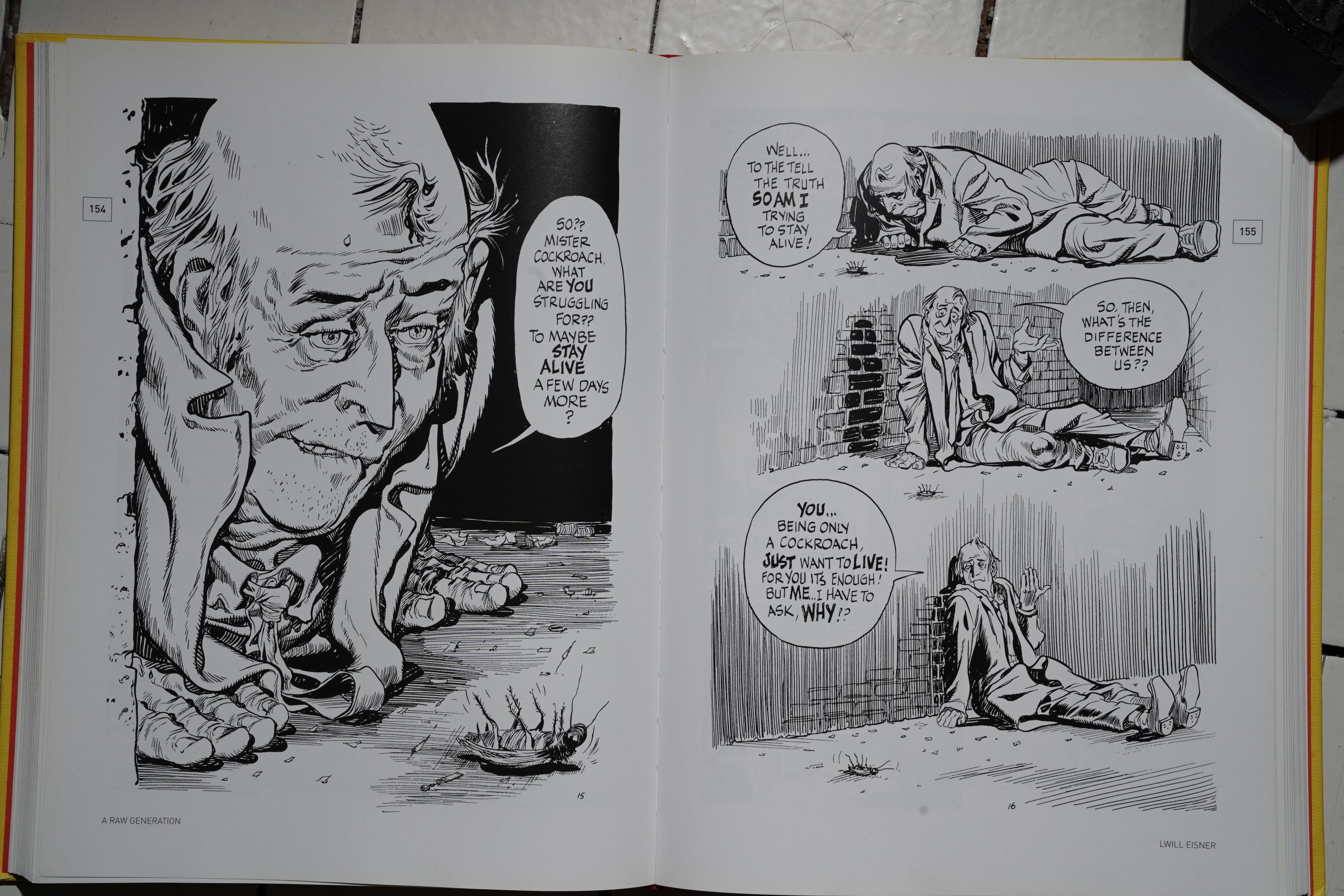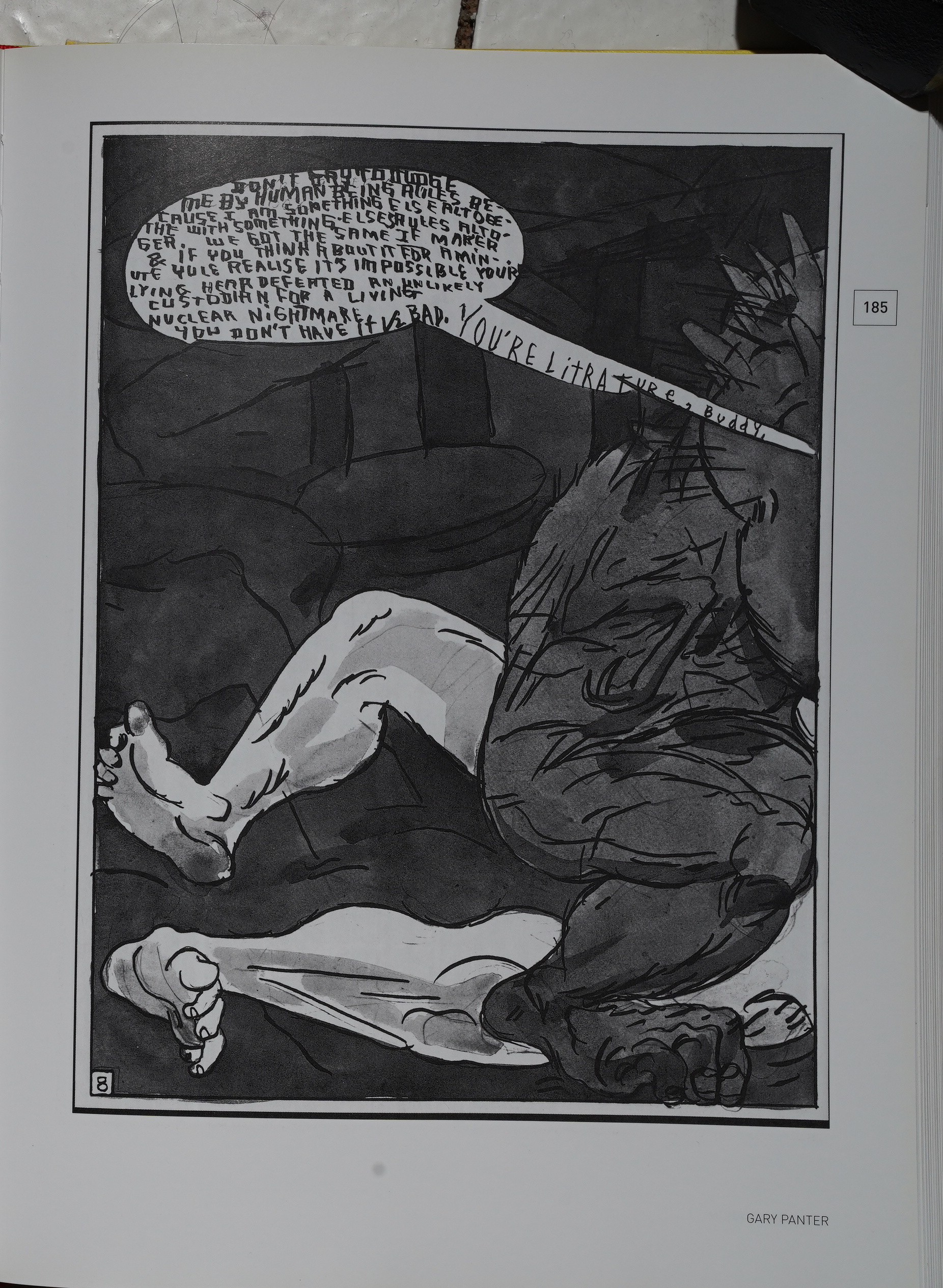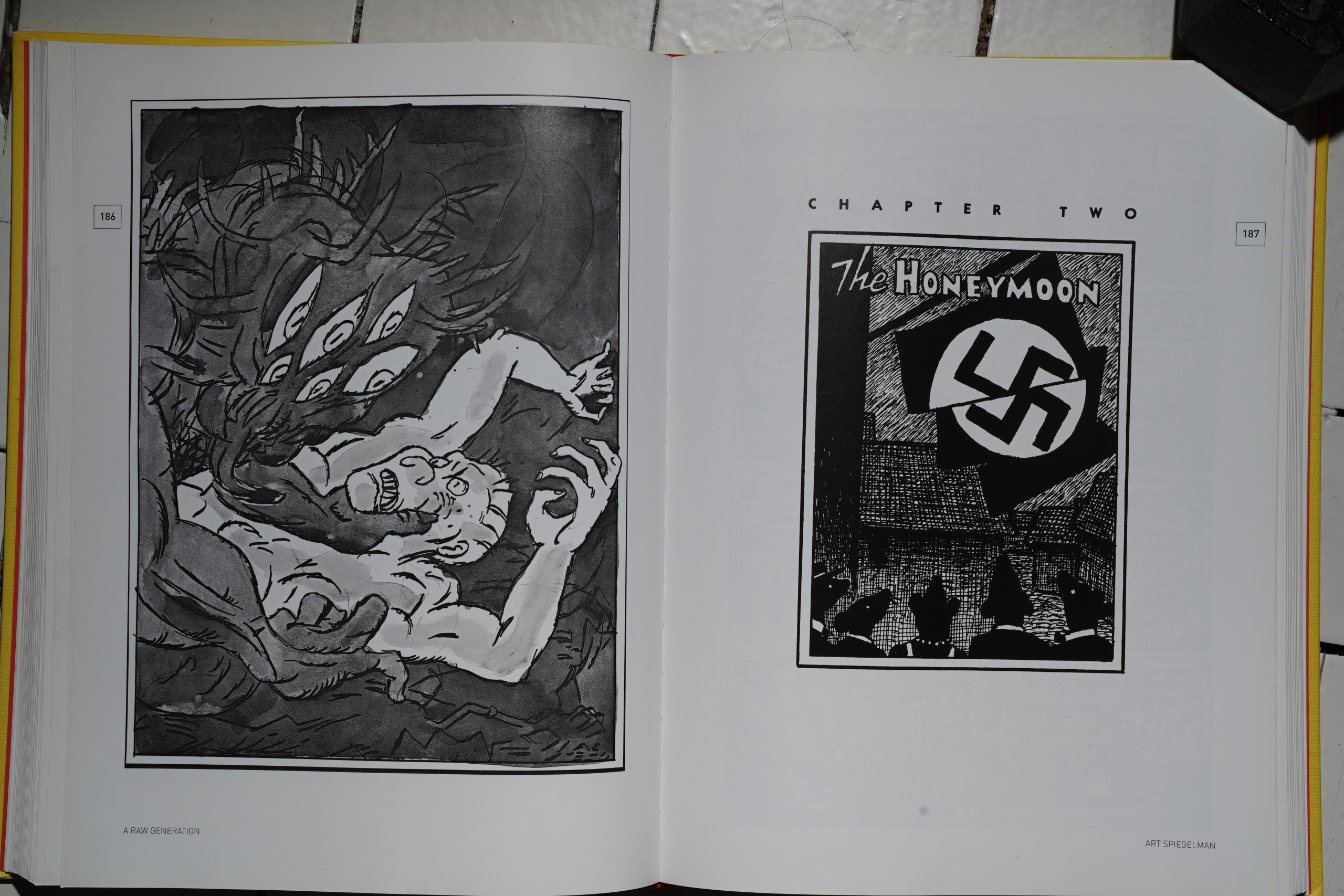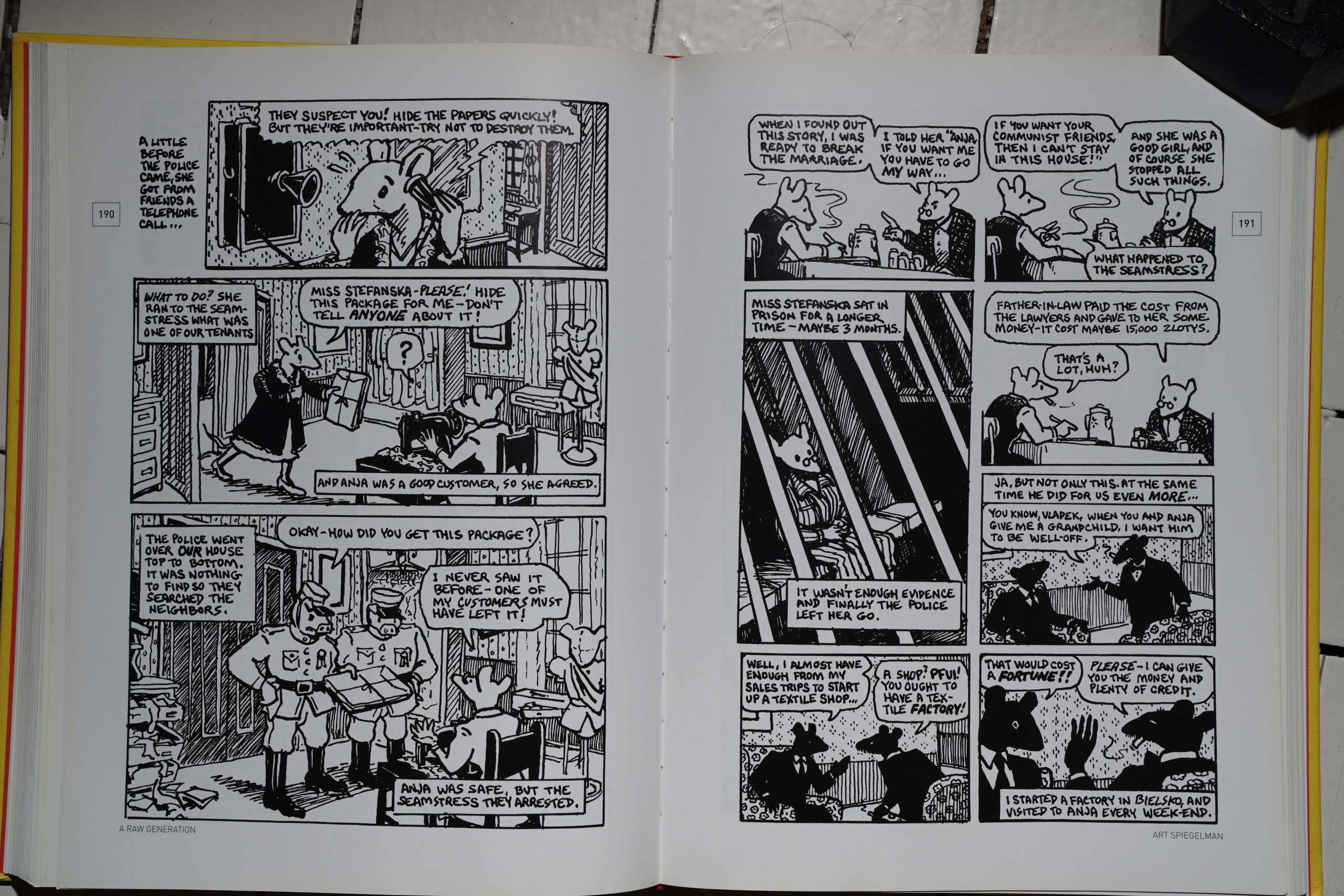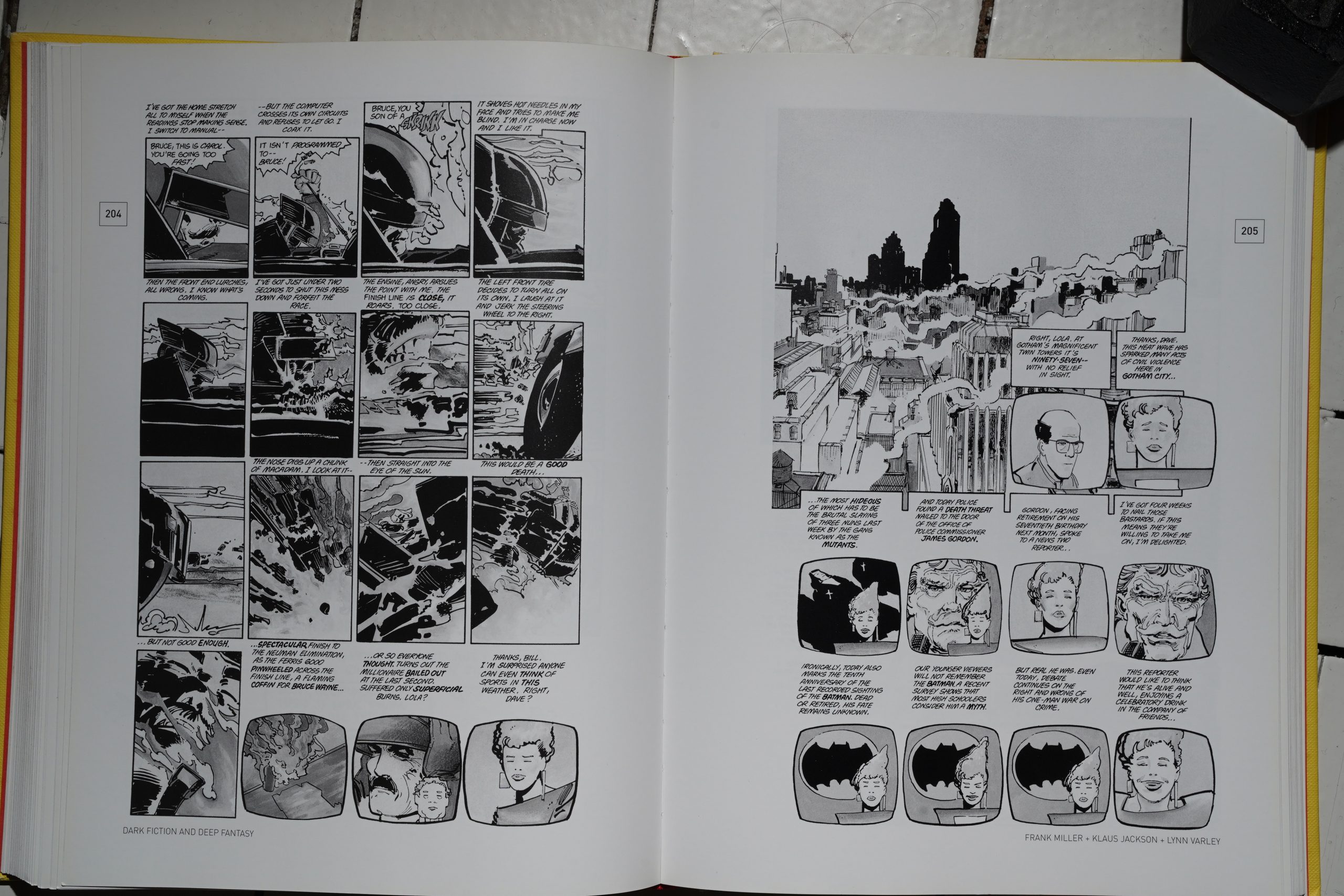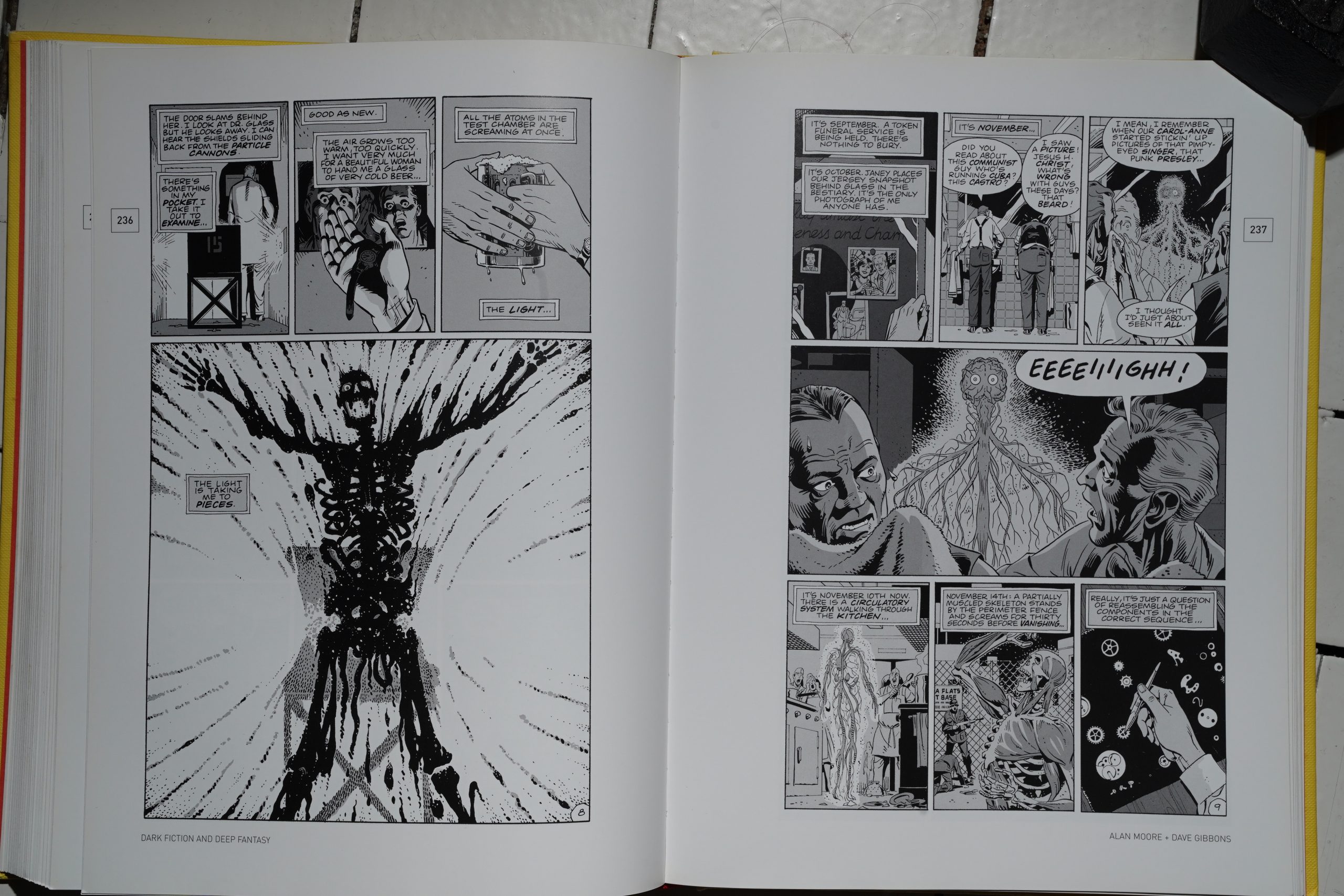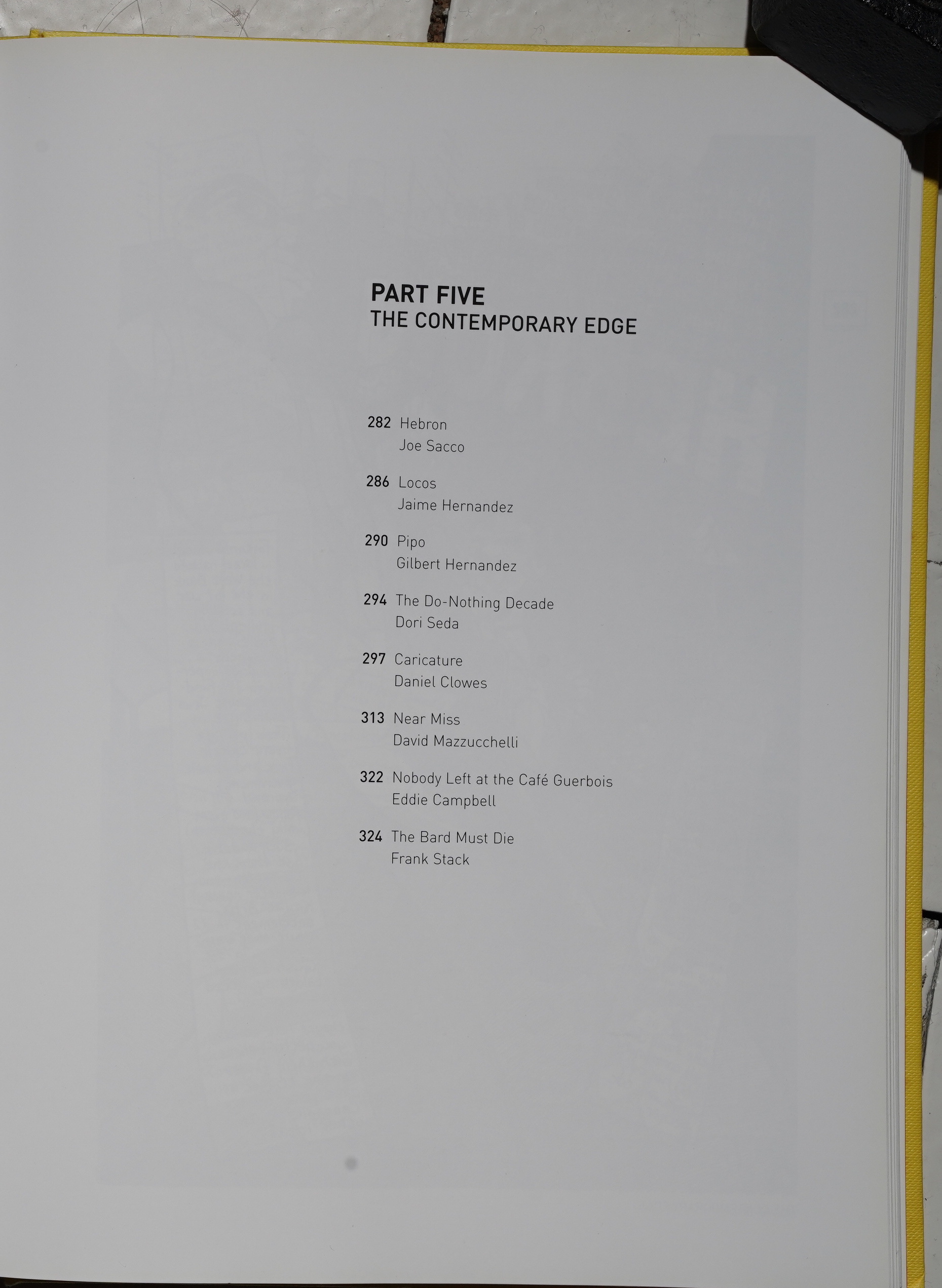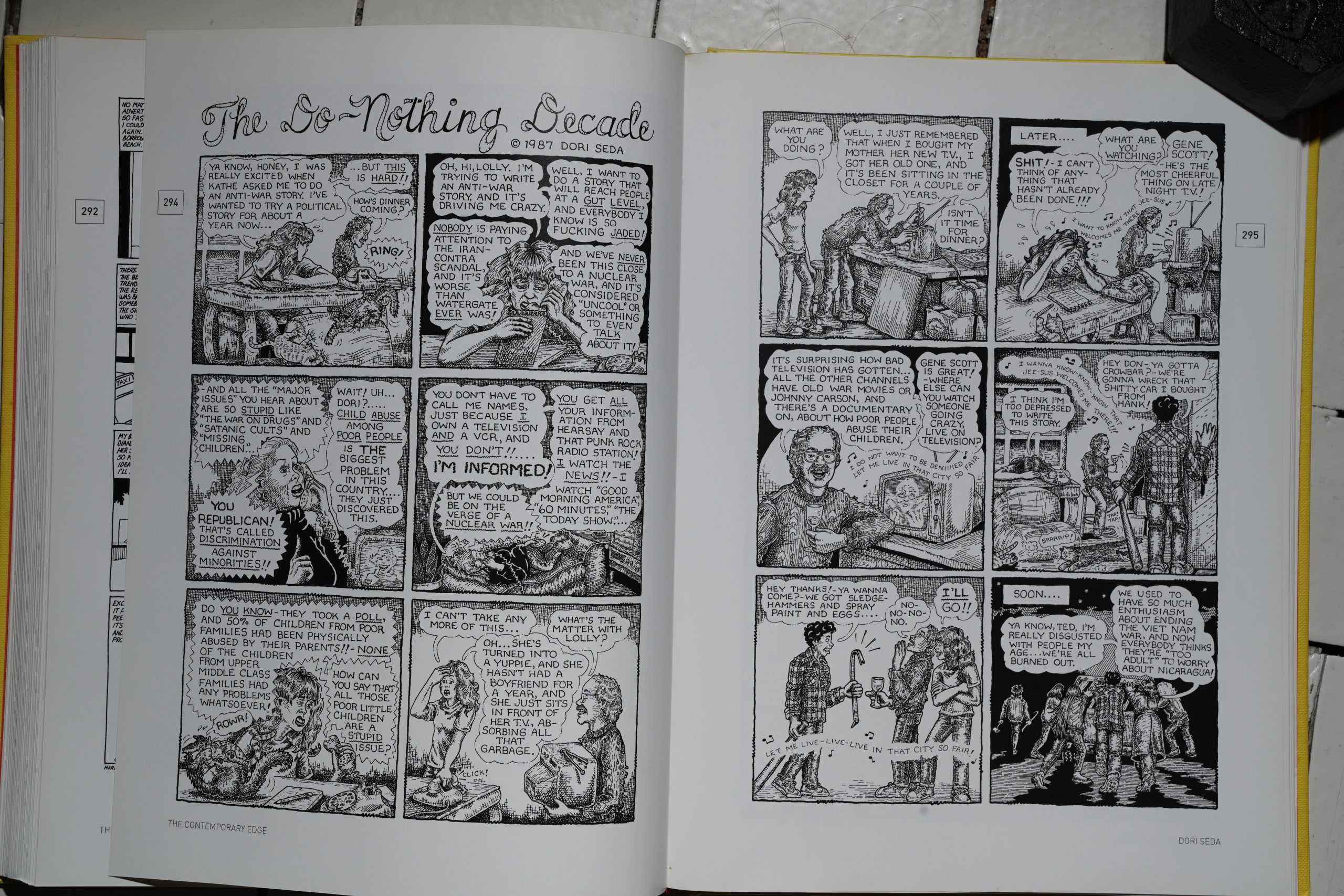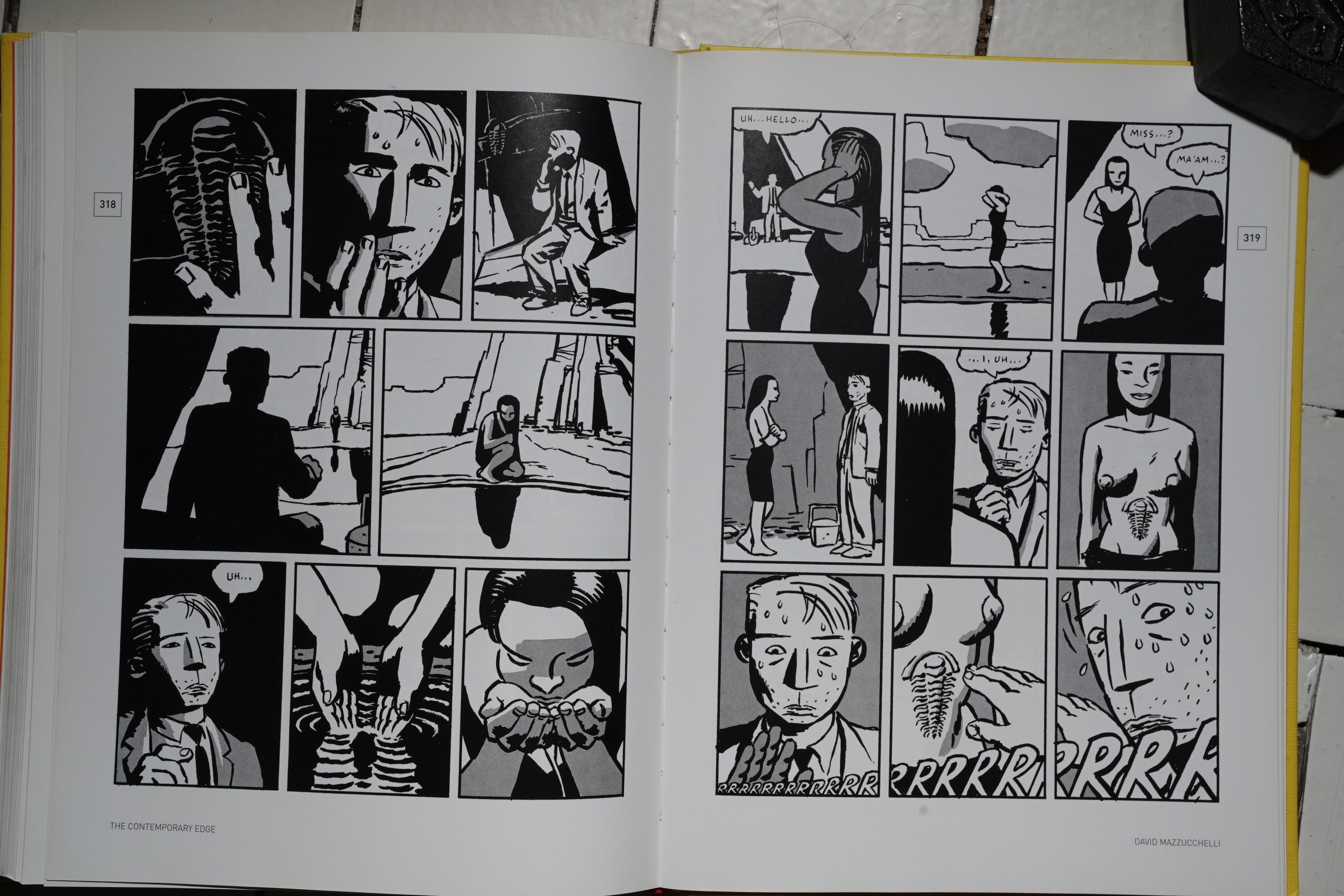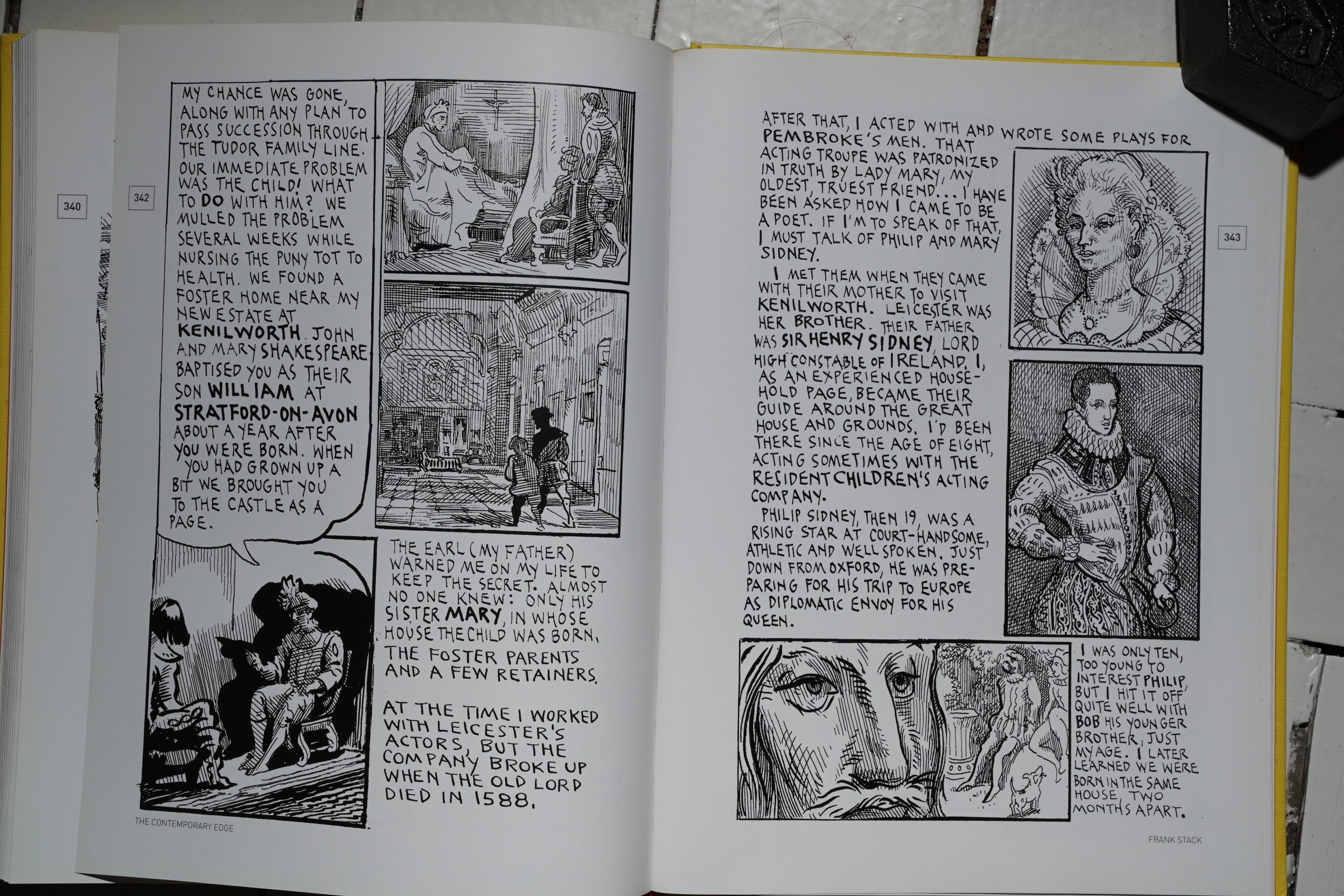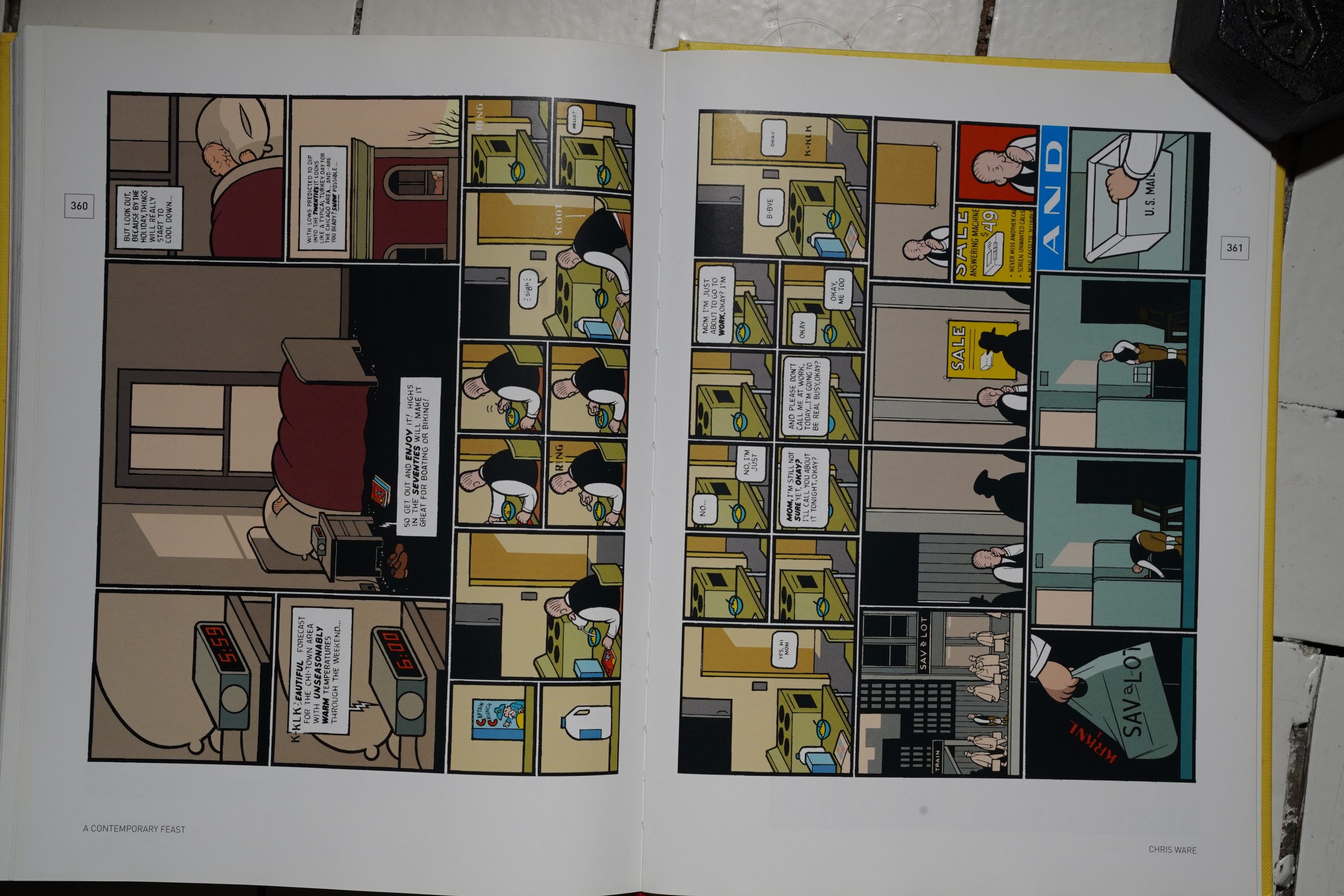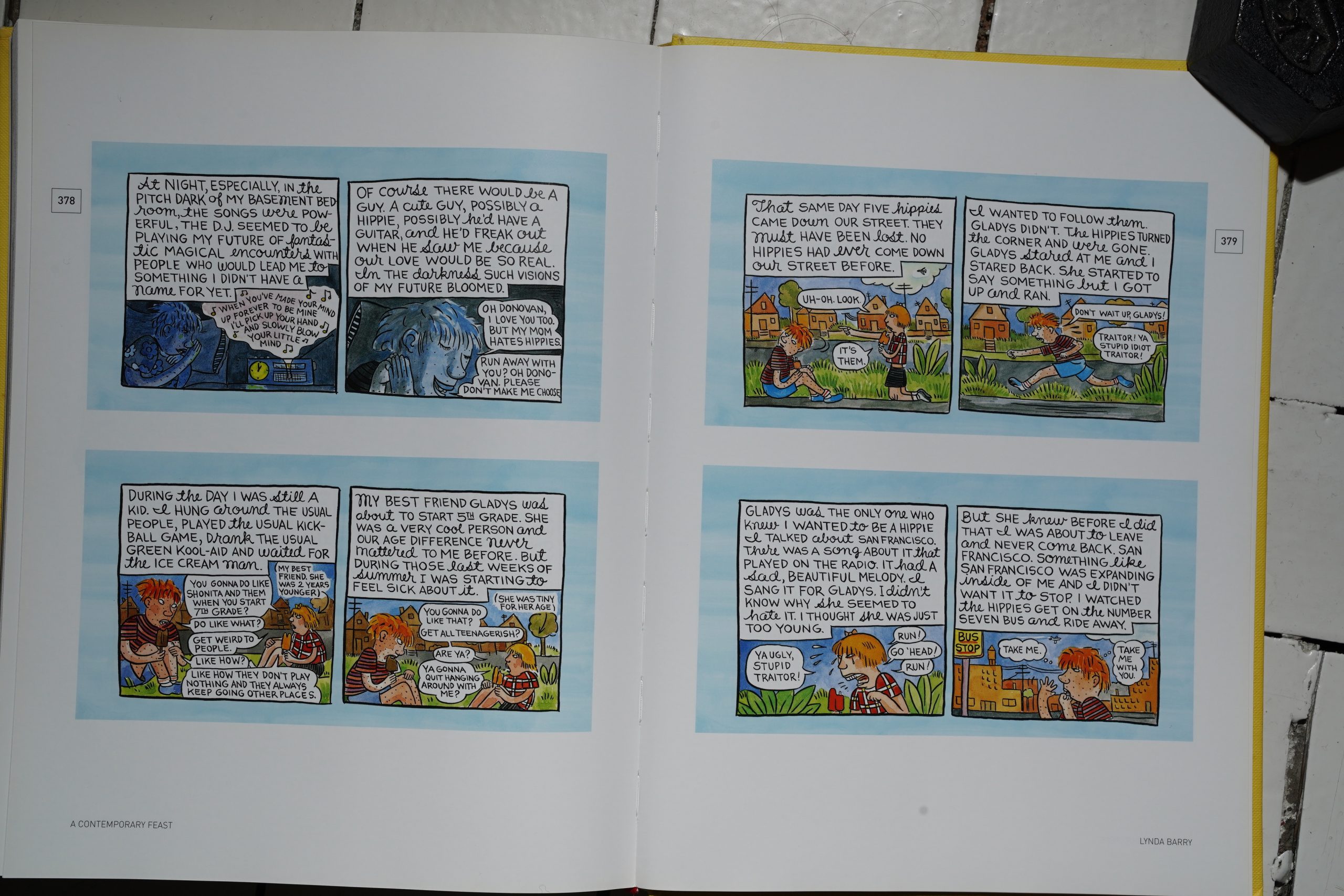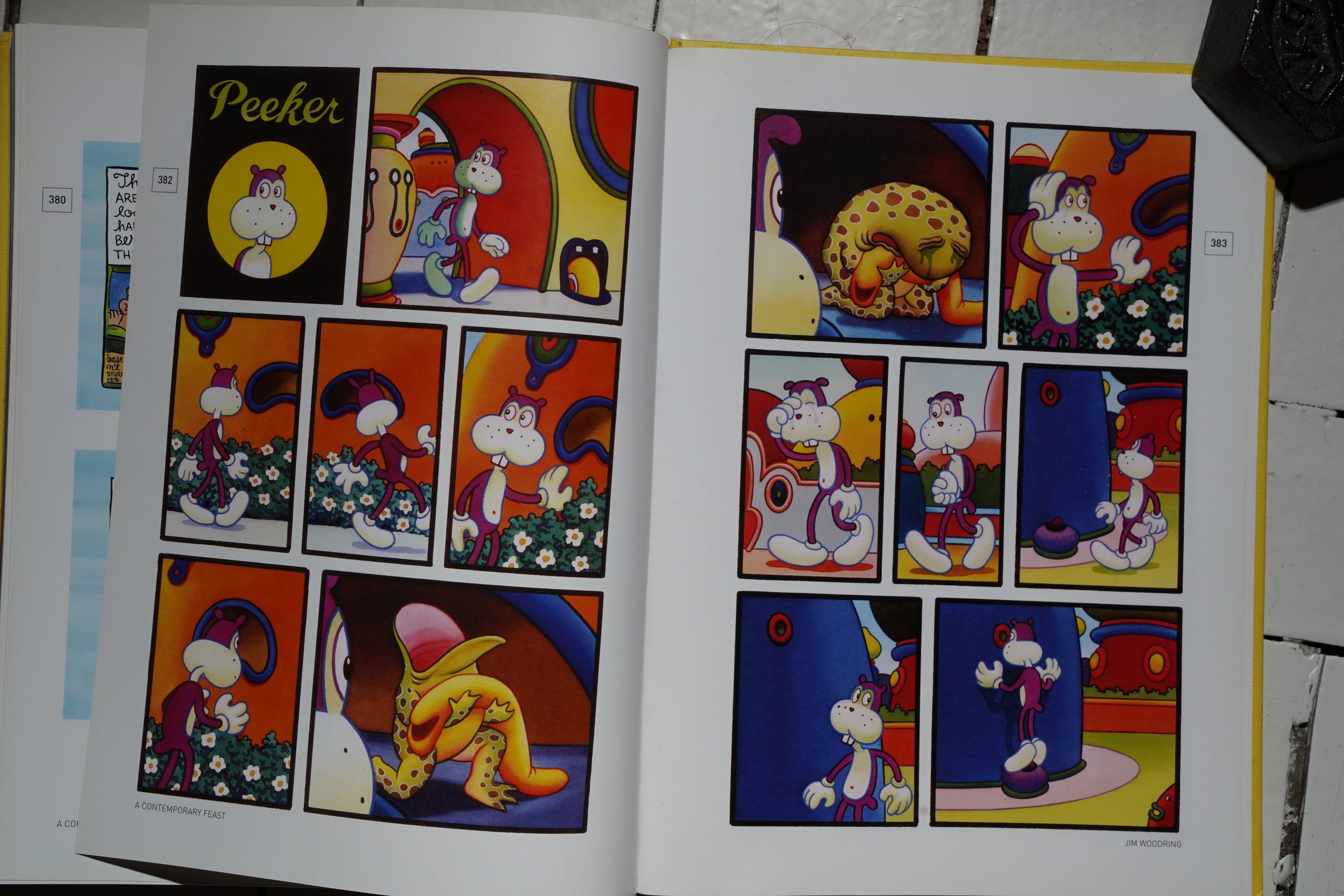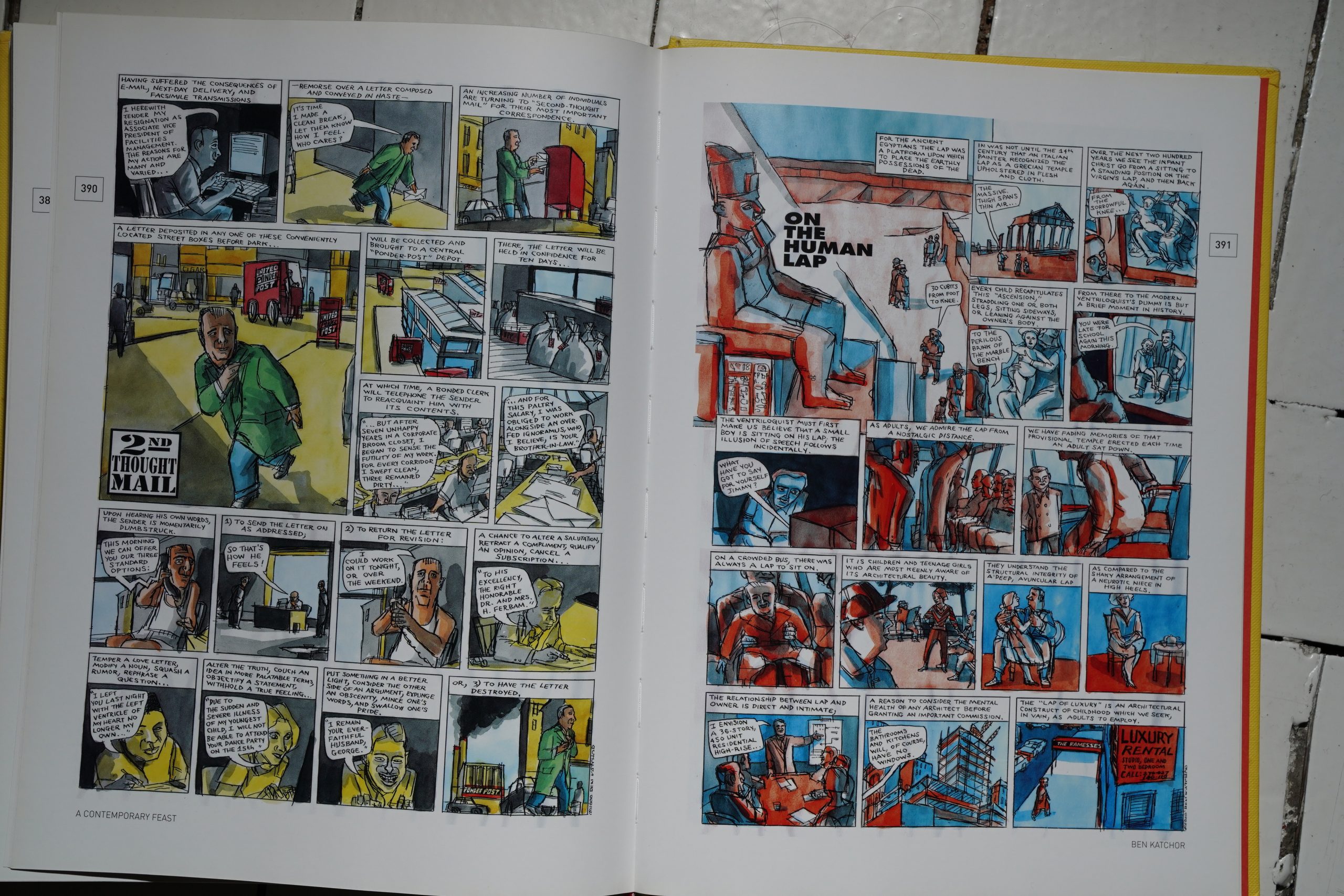The New Smithsonian Book of Comic-Book Stories: From Crumb to Clowes edited by Bob Callahan (220x284mm)
Callahan had previously had a go at creating a book like this in 1991: The New Comics Anthology. It wasn’t entirely successful — it read more like a catalogue than an anthology (and the artists had difficulties getting paid, the reproduction was pretty bad, and it sank without a trace in the marketplace).
But now he’s back — and the Smithsonian is probably more supportive than his previous publisher, Macmillan (who needed a lot of persuasion to include the more avant garde artists, apparently).
The main problem with the previous book was that there were so many contributors that the median story length was two pages. It doesn’t look like that’s going to be a problem here…
We begin with an overview of comics history, and it’s OK, I guess.
Ooh! The Upper West Side! Swanky!
The comics start off with a section about the Undergrounds, so R. Crumb leads the pack. The reproduction’s OK — shiny paper and very black ink, so it looks nice. But it’s just a tad too small, innit?
The previous book was plagued by production issues, like running pages out of order… and it looks like this has a similar lack of quality control: The Freak Bros. story repeats a page and neglects to include the final page of the story.
The selection of Undergrounds is reasonable, I guess, if you’re only including a handful of people. Callahan seems to be building a somewhat idiosyncratic gallery of people: We don’t get any of the “out there” artists, but only the extremely narrative-heavy people. But, you know, can’t complain about Spain… it’s a good story to include, too, if you’re only doing one Spain story.
And then… Carol Tyler!? As an Underground artist? Well… I guess she works in that idiom… And, again, it’s a good strip. (It was also included in the New Comics anthology).
And then Crumb again, but with Harvey Pekar.
So: The Undergrounds were just about doing autobio. Check!
Then we go to the super-hero section, and we get three Stan Lee things, taking up more than 60 pages. First out is a Captain America story with artwork by Jim Steranko (and probably an inker? Callahan doesn’t mention the inkers on any of the super-hero stories anywhere). It’s a sappy story about Captain America faking his death and fighting the Nazi Hydra org.
I got very confused, because in the middle of the story, there was this page? Was it inserted to get the correct left/right-hand page thing going for the subsequent pages?
Then we get it again at the end of the story. I’m guessing this was meant to be this way, but it’s … weird.
The third Lee story is the one where Spider-Man saves his aunt (by doing a blood transfusion), and it’s very soap-operaish. (When I say “Lee story” here I take it as read that the artists really created the story. At ease! No need to comment!) But we get this Fantastic Four story which has a lot of fighting indeed, and Kirby has them fight the Hate Monger (who is really Adolf Hitler (or a clone (oops spoilers))).
It’s, again, a very lop-sided view of super-heroes, but the selections aren’t bad? Callahan is definitely building some kind of narrative through his selections: Comics are all about auto-bio and fighting Nazis. Check!
And here we come to the reason I’m doing this book in this blog series: “A Raw Generation”. In the New Comics book, he called the sorta-kinda equivalent section “Punk Comics”, but by 2004, it was getting pretty obvious that this kinda-sorta approach to comics had changed name.
And… the first artist here is…
Will Eisner.
I think it’s one of the stories from Dropsie Avenue? Uhm…
Hey, Melinda Gebbie! She’s awesome, and it’s a really smart choice, but is Callahan pointing to her as being part of the Raw Generation? She seems more like a second-wave Underground artist to me.
The pieces in this section are a lot shorter than in the other sections. In the New Comics book, Callahan had problems convincing the editors that it’s smart to put some avant garde stuff in the book (so that section was mostly single-page items), and perhaps that was the case here, too? We get, for instance, a badly reproduced Malpractice Suite from Spiegelman and a one-page thing from Kaz. Both are good choices, but…
An why not do the two-page Spiegelman strip as a spread?
Callahan includes the final chapter of the original Jimbo sequence (by Gary Panter), and it’s a great choice: It’s absolutely awesome. But again — we get the two final pages as a right-hand-page…
… and then a left-hand page. It’s bizarre! Didn’t the people doing the layouts look at the comics at all?
And speaking of weird — it’s jarring to see Maus printed this large.
And… then we get more lengthy reprints of super-hero comics. But the “modern” ones (i.e., made 20 years before this book was made). So here’s Frank Miller (et al) with a Dark Knight excerpt…
… and we get an entire issue of Watchmen? I mean, it’s a nice issue, but…
Finally, we get more… er… edgy? work. The Contemporary Edge.
Which includes an almost 20 year old Dori Seda story. Again, it’s a great piece — I’ve said this a lot, but Callahan has good taste — but it feels like he’s given up on coherence.
The David Mazzucchelli piece here is more like it. I mean, it’s from 1991.
The most puzzling piece of all here is a 35 page story by Frank Stack. I love Stack’s work, but this basically sums up all the most moronic ideas about Shakespeare, and adds some illustration. It’s almost not a comic at all, and it’s totally tedious. (Did I mention that it’s also stupid? I did? OK.) I started wondering whether Stack was going to go “and if you believed anything of that, you should check yourself” at the end, but no.
And then… A Contemporary Feast? Eh?
Oh, it’s the colour section. Well… OK. We start of with a pretty random selection of Chris Ware pages, but these have been selected by Ware himself, apparently? It’s an utterly baffling selection, which leaves me wondering whether they messed up somehow in production. (And printing stuff sideways in such a large and heavy book is less than amusing.)
Lynda Barry, with some strips from One! Hundred! Demons!, which is cool.
So is the Jim Woodring piece.
And… whoa… Ben Katchor? These are apparently pages from Metropolis magazine, and… I’m not sure I’ve read them before? The one of the left feels familiar, but I don’t think I’ve seen the one on the right? And such gorgeous colours! I had no idea! I mean, Katchor mostly works in grey washes, but I guess these are watercolours? Fabulous.
And that’s the book.
It’s a bit difficult to say who this book is for? I guess it’s a good overall introduction to comics — it’s a good mixture of stuff, with shorter and longer pieces: it reads well. It just feels a bit under cooked, like a bit more work could have gone into the selection of pieces, the sequencing, and the production work.
Mark Campos writes in The Comics Journal #267, page 51:
The Smithsonian Book of Comic-Book
Comics, 24 years after its publication,
still throws a long shadow. Before it, there
were dozens of books that promised 10 tell
the history Of comics, but most were either
stuffed with camp (the Batman TV show
still exerts its lunar pull to this day) or were
held together carelessly, With slack schol-
arship and crappy art reproduction. The
Smithsonian book’s editors, Michael Barrier
and Martin Williams, conducted themselves
With dignity, writing lucid historical essays
and selecting top-rate examples of the com-
ics art form. Between its pages were some
of the first rediscoveries of then-forgotten
old masters Will Eisner, Jack Cole and Shel-
don Moldoff; until recently, it was the Only
Widely available sampling Of the dada glories
of George Carlson’s “Pie-Faced Prince of
Pretzelburg.” Its presence in the of
almost every library in the United States
gave thousands of kids their first taste of the
glories Of comics’ Golden Age.
[…]A follovFup to the Smithsonian book
seemed like a good idea. Crumb is in The
New Yorker, Ware is in the Whitney, Speigel-
man Wins a Pulitzer, Spider-Man is Tobey
Maguire — it’s time to recap what happened
there, right? When plans to publish The New
Smithsonian Book of Comic-Book Comics, to
be edited by Bob Callahan, were announced,
fans and readers anticipated another deeply
satisfying collection Of stories and history,
like the first book. It’s probable that even the
best effort would have a hard time following
that classy first volume. Hank Williams Jr. is
great, but
people still
compare him un-
favorably to his Old
man. (In the song “Liv-
ing proof”, Hank Jr. sang:
Why just the other night after the
show an Old drunk came up to me / He says
you ain’t as good as your daddy, boy, and
you never Will be.”) Even without comparing
to its predecessor. though, The New Smith-
sonian Book Book Comics (l call it
Smithsonian Jr.) would be disappointing.
First off, there are
serious production flaws
with this volume. The last page of Gil-
bert Shelton’s “The Death of Fat Freddy”
story is missing, replaced with a repeat of
the second page. There is a mysterious page
in the middle of “The Death of Captain
America,” which is a later page reprinted but
blurred weirdly — it’s a space-saver page
from an earlier reprint, originally used to
keep the spreads in sequence (but its inclu-
Sion throws them out of whack here). Two
pages of “Caricature” by Dan Clowes
are printed Out of sequence, exception-
ally galling since the art has page
numbers written at the bottom.[…]
Is this book a history? A hagiography?
Choices veer between historically important
and personally representative. The Crumb
Story isn’t from his innovative period, it’s a
Weirdo-era piece, though it deals with the
•60s era. If the goal is to Show how influ-
ential Crumb has been, Why not use a page
or two Of the influential work? As often as
they’ve been reprinted, as familiar as the
characters are, and as obvious a choice it
might have seemed, perhaps one Of his well-
loved Zap stories might have been a better
selection. Anything before Fritz the Cat had
his meeting With the fatal icepick Would
suffice. My choice would have been the
“Cheesus K. Rcist” Story from Zap #1 —
the
perfect cocktail of bigfoot Americans, danc-
ing ketchup bottles, and metaphysics, the
Story that launched a thousand ripoff Com-
mercial designs. And yet “The Death Of Fat
Freddy” strikes me as the perfect representa-
tion Of Gilbert Shelton’s comedic brilliance,
which was always Offset in the best way by
Paul Mavrides’ art. Mavrides perfectly Cap-
tured the way gentle San Francisco had, by
1978, become dangerous and reptilian, and
the sight Of Shelton’s amiable Freaks Wan-
dering those mean streets always made me
chuckle. Shame the last page is missing.[…]
The Silver Age superhero stories are
by Lee/Ditko, Lee/ Kirby, Lee/Steranko, and
Kanigher/Kubert. Fuzzy black-and-white
reproduction nearly ruins the Spider-Man
and Fantastic Four stories here, but even
thick lettering and furry outlines can’t ne-
gate the primal power of Ditko’s character
design, or dim the wackiness of Kirby’s
baroque machines and faces. The Fantastic
Four story contains my new favorite single
panel: “Hey, What’s With the mad scientist
bit?” “I’m just shutting down some nuclear
activators so I can hear you better.” The
Captain America Story looks less innovative
than it must’ve, once; half the Enemy Ace
tale could have been left on the cutting room
floor, but it seems more influential than it
probably — wasn’t making a sympa-
thetic character out of an enemy combatant
against the Code? Speaking of the Code: As
regards the mainstream we go straight from
Code-era to post-Code without making any
stops, and it’s unclear what historical forces
led to those changes. More background info
here, please.
There are only three women repre-
sented: Dori Seda, Carol Tyler, and Melinda
Gebbie. At least one web commentator has
speculated that the only reason Melinda
is included is because she’s partnered with
Alan Moore. That’s hard cheese — her work
was out and around long before she hooked
up with Moore — but if we’re picking to-
kens, why her instead ofTrina Robbins or
Shari Flenniken or Roberta Gregory or Aline
Kominski-Crumb or Julie Doucet or Megan
Kelso? The Carol Tyler Story is nice, and
appreciate that Callahan didn’t select “The
Hannah Story,” which would have looked
awful if the lavish and emotional colors had
been changed to grey tones. Seda’s Story is
uncharacteristically free Of dog-fucking, and
Will shock nobody, so is not really represen-
tative Of her best work.
“Uncharacteristic” describes many Of
the selections found in the later part Of the
book. A chapter Of is a fine excerpt
from that work, and “Caricature” is one Of
the strongest Clowes stories there are (shame
about the pages being scrambled); but both
Hernandez brothers are represented by weak
choices. I’m guessing that Callahan saw this
as an opportunity to entice new readers into
the Hernandez’s mythos, since both the Jai-
me and Beto stories mention but don’t really
show their major characters, quietly asking
“Don’t they seem interesting? Wouldn’t you
like to learn more about them The Beto
Story is less than successful at that: Four
pages Of yattering about Luba and
Khamo and Gato and Carmen is too insular
to intrigue a newbie.[…]
As for the Bard, Frank Stack’s “Shake-
speare Must Die!” is a gabfest Of incredible
proportions. The pages turn to text blocks
as the chatter builds up — not that it’s un-
interesting. And just When you’re ready to
give up on the verbiage and go ogle the girl
in the Chris Ware Story again, Stack throws
in a couple panels Of his accomplished figure
study work, which will keep this book off
the Wal-Mart shelves for sure now (except
that the W M good-taste police Will crap out
on the Story after page two).[…]
That’s a serious amount of omission.
You can’t really tell the story of mod-
ern comics without mentioning how the fan
press, which gave the underground its first
and best, mutated into the small-press scene
— and continues to introduce new talents to
the comics world. You have to mention the
black-and-white boom, the Teenage Mutant
Ninja Turtles and their imitators, and once
there you might as well go into the Tundra
debacle. The success Of the Turtles enabled
the Xeric Foundation to fund a load of bril-
Kant work by new creators (and some dross,
true). And there’s direct causality between
the Turtles’ and the Pokemon merchandis-
ing phenomena, Which greased the skids for
the manga boom in the United States. Then
there’s the French influence (Moebius, Tin-
tin, et al); the Canadian renaissance (Sim,
Seth, Chester Brown, Julie Doucet); the Jap-
anese (Tezuka, Rumiko Takashi, CLAMP);
the gay and lesbian creators (Howard Cruse,
Alison Bechdel), the New Zealanders .
See? In the end, one winds up making
lists of the omissions in this book. Maybe
it isn’t supposed to be a strict history of
modern comics, but as an overview, it’s shal-
low — McSweeney’s #13 beats this volume
all hollow. Odd selection, shaky scholar-
ship, bad printing, low budget: The New
Smithsonian Book of Comic-Book Comics is
a fumbled opportunity. You ain’t as good
as your daddy, boy, and you never Will be.
I think he didn’t like it.
Callahan purports to cover the scope of comics from the last 40 or so years, but leaves out hugely influential figures in contemporary comics, including Mark Beyer, Aline Kominsky, Julie Doucet, Phoebe Gloeckner (there’s a severe dearth of female cartoonists), Howard Chaykin, Chester Brown, Todd McFarlane, S. Clay Wilson, Dave Sim and many, many others. Instead, there are minor works by minor cartoonists like Rick Geary, Melinda Gebbie and Frank Stack, and jumbled or inconsequential work from great cartoonists like Gilbert Hernandez, Kaz, Joe Sacco, Jack Kirby and Steve Ditko. Neither a definitive anthology nor a helpful resource, this is a haphazard grab bag of some good comics, numerous dubious achievements and some downright mysteries.
This blog post is part of the Punk Comix series.
